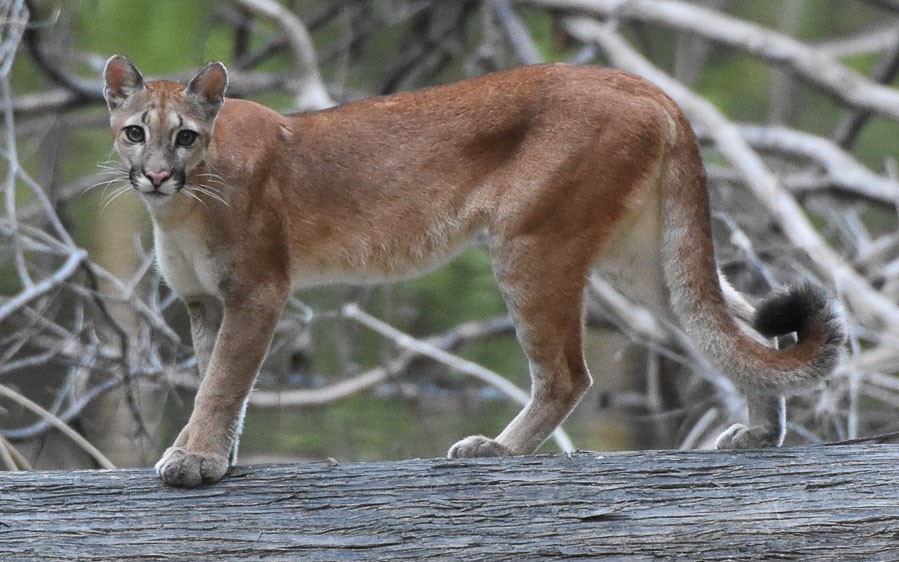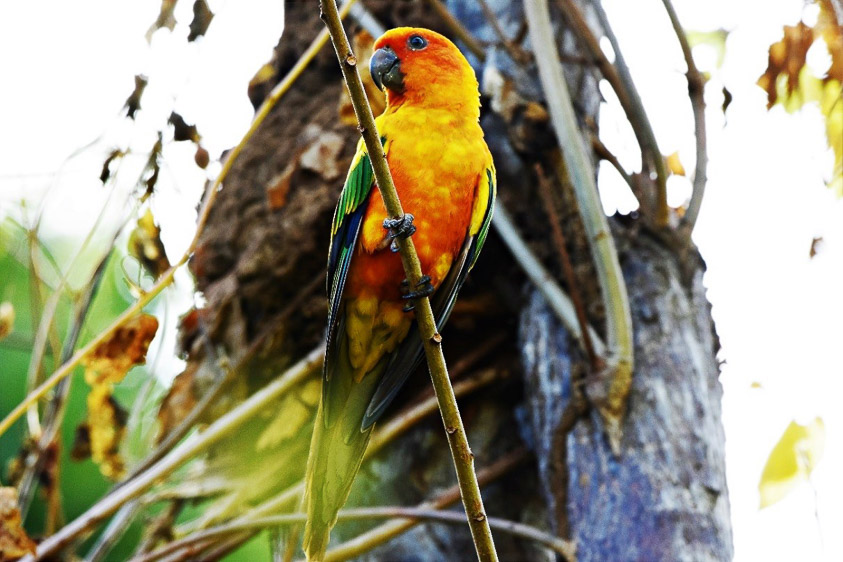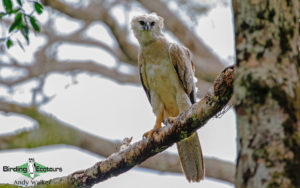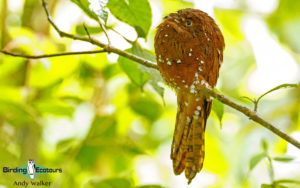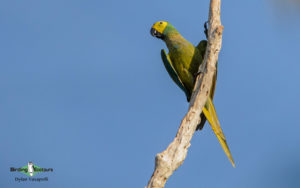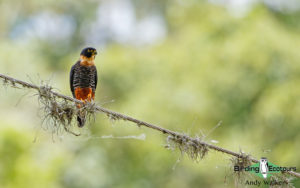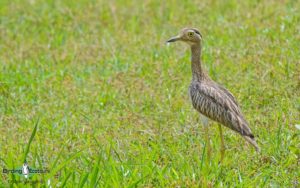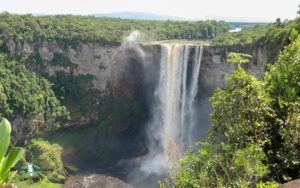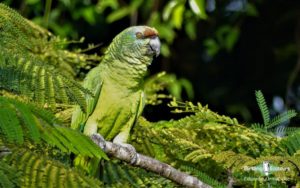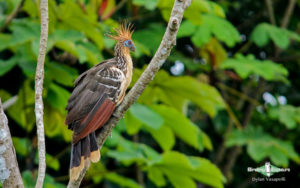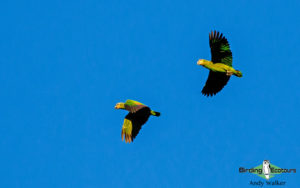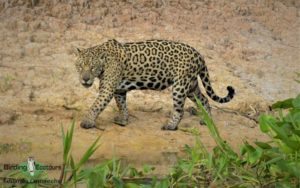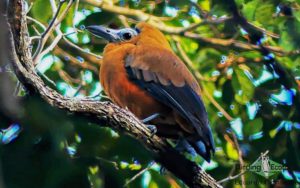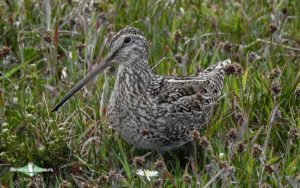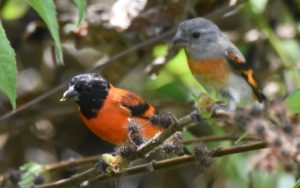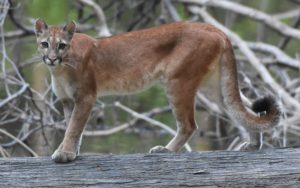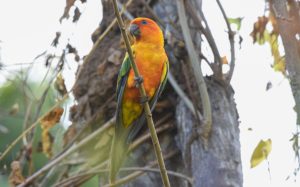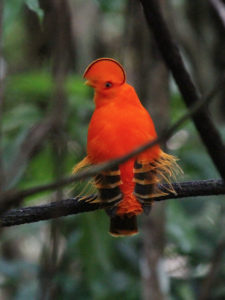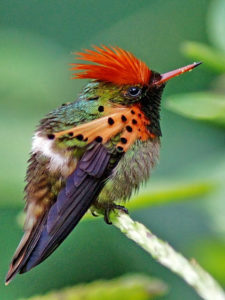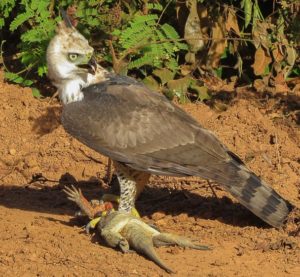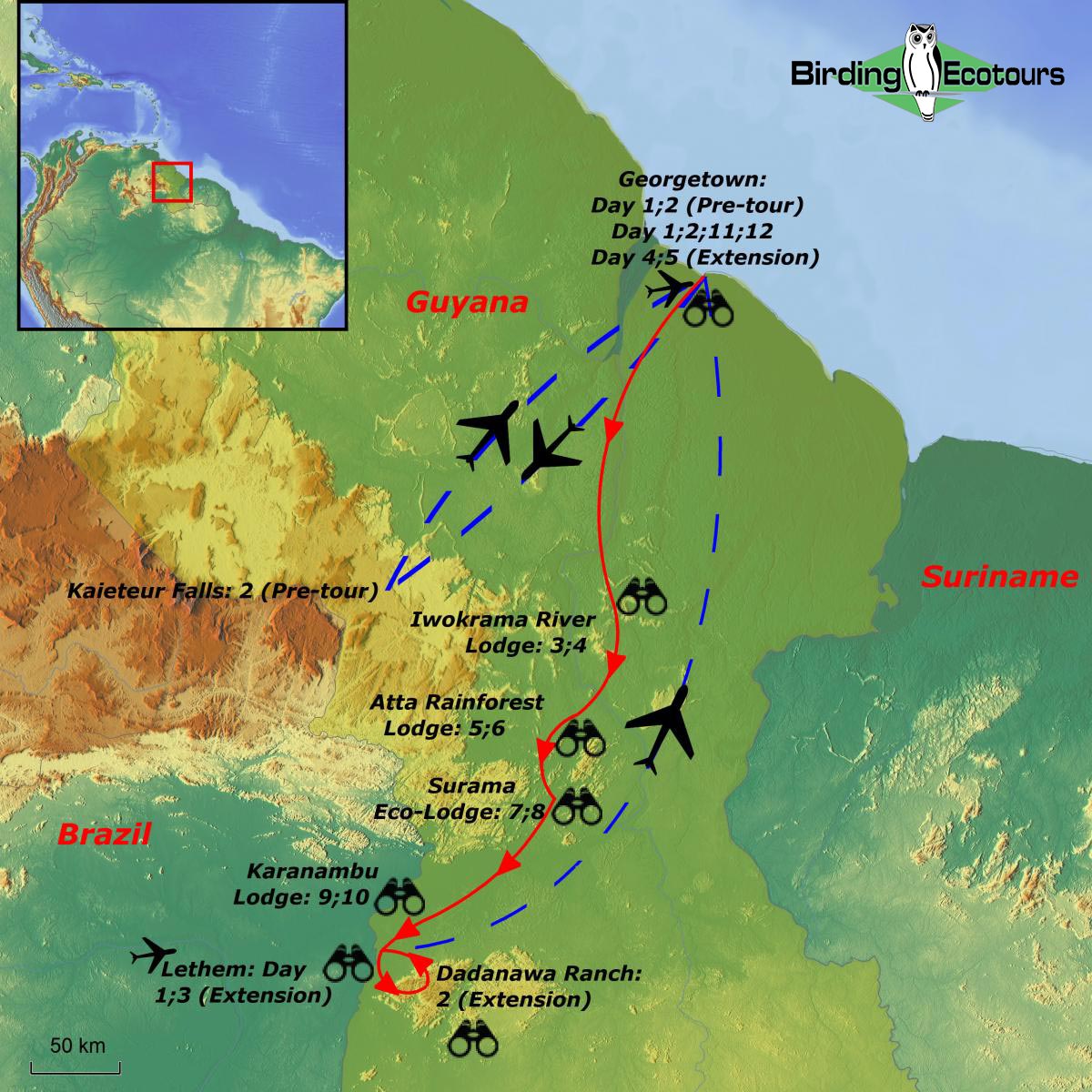Birding Tour Guyana: The Lost World – Guiana Shield Specials and Sun Parakeet
Go to: Guyana Birding Tours | Birding Tours in the Neotropics | All our birding tours
Birding Tour Guyana: The Lost World – Guiana Shield Specials and Sun Parakeet
January 2026
Guyana conjures up visions of one of the last few truly wild places on Earth that still holds incredible landscapes covered by thousands of miles of untouched rainforest, pristine forest rivers, water lily-covered lakes, rolling grassland and savannas, and magnificent, breathtaking waterfalls. Guyana truly gives visitors the sense of being in the Lost World.
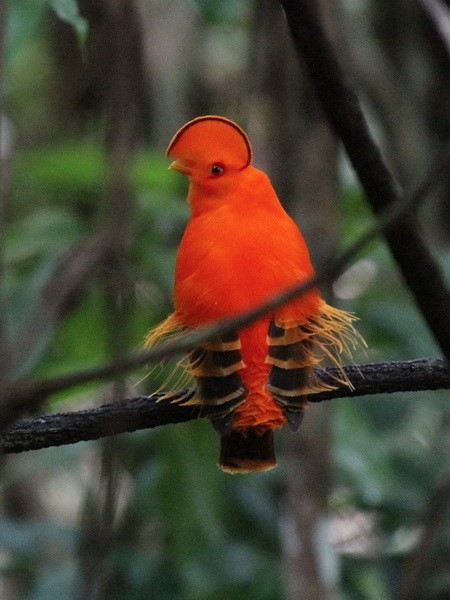
This relatively small country, found in northeast South America, has become a mandatory destination for adventurous birders as it hosts many species that are hard to find in adjacent South American countries. Some of these species include Capuchinbird, Black Nunbird, Crimson Fruitcrow, Blood-colored and Waved Woodpeckers, Black and Crestless Curassows, Bearded Tachuri, Red-fan Parrot, and Rufous and White-winged Potoos. It also offers great chances for Harpy Eagle, if there are active nests in the area. With the help of our Birding Ecotours leaders and local guides we will do our best to find this most-wanted and massive raptor. In addition, Guyana offers a unique set of species called Guiana Shield specials, including Guianan Toucanet, Guianan Trogon, Guianan Red Cotinga, Guianan Streaked Antwren, and Guianan Puffbird. There are also good chances for some forest species including White-plumed Antbird, Rufous-throated Antbird, and with luck Rufous-winged Ground Cuckoo.
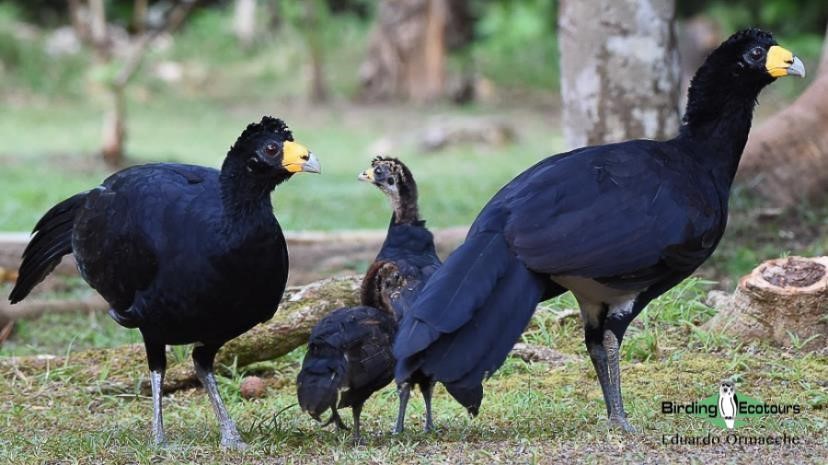
Our 14-day Guyana birding tour is designed to explore the best that this country has to offer to birders in two parts. The first part takes in the coast at Georgetown, looking for the localized Rufous Crab Hawk and Scarlet Ibis. We will then explore the awesome Kaieteur Falls and visit a lek of the gorgeous Guianan Cock-of-the-rock near Surama Eco-Lodge, where we will be based. Next up are the rainforests of Atta Rainforest Lodge with its magnificent canopy walkways which should give us eye-level views of several canopy-dwelling species. The second part of the trip includes long 4×4 drives exploring remote Amerindian communities in search of two localized, Endangered, and most-wanted species, Sun Parakeet and Red Siskin. We will make all possible efforts to provide you with these unique species as well as the localized Rio Branco Antbird and Hoary-throated Spinetail.
Finally, Guyana also offers visitors good chances of encountering interesting wildlife, with sightings of Giant Otter, Giant Anteater, and even Puma and Jaguar are not uncommon in this fantastic country.
We may get lucky with a Puma sighting (photo John Christian).
Itinerary (14 days/13 nights)
Day 1. Arrival in Georgetown and transfer to the hotel
You will arrive at Cheddi Jagan International Airport, located 25 miles (40 kilometers) south of the capital city, Georgetown, meet our local representative, and transfer to the hotel. Dinner would be for your own account tonight.
Overnight: Cara Lodge, Georgetown
Day 2. Mudflats birding, Mahaica River boat cruise, and Georgetown Botanical Gardens
Today we will have an early start to head to the Atlantic coast and check the mudflats for the beautiful Scarlet Ibis. We will then continue towards the village of Mahaica, where we will take a boat trip along the Mahaica River. Among our targets will be Guyana’s national bird, the bizarre and distinctive Hoatzin. We will also look for a host of other species, including Rufous Crab Hawk, a localized Guyana special. Other target birds include Black-collared Hawk, Black Hawk-Eagle, Long-winged Harrier, Barred Antshrike, Silvered Antbird, Mangrove, Striped and Little Cuckoos, Green-tailed Jacamar, Blood-colored Woodpecker, White-bellied Piculet, and Mangrove Rail. Depending on the level of the tide we may be able to check the shoreline for waders, including White-rumped and Western Sandpipers, Hudsonian Whimbrel, Grey Plover, Short-billed Dowitcher, and other coastal and typical aquatic species such as White-cheeked Pintail, Tricolored and Little Blue Herons, Yellow-crowned Night Heron, Magnificent Frigatebird, Royal, Gull-billed, and Least Terns, and Brown Pelican.
After lunch we will visit the famous Georgetown Botanical Gardens. This parkland area with open grass, scattered trees, bushes, and several ponds is famous for holding a good selection of species, including the localized Blood-colored Woodpecker. In addition we will look for White-bellied Piculet, Spotted Tody-Flycatcher, Yellow-chinned Spinetail, Rusty-margined Flycatcher, Southern Beardless Tyrannulet, the impressive Toco Toucan, Black-capped Donacobius, Wing-barred Seedeater, Straight-billed Woodcreeper, Black-collared Hawk, and a colorful and noisy selection of parrots, including Red-shouldered Macaw, and Orange-winged, Yellow-crowned, Southern Mealy, and Festive Amazons. Flowering trees may support hummingbirds such as Black-throated Mango, and White-chested and Plain-bellied Emeralds.
Overnight: Cara Lodge, Georgetown
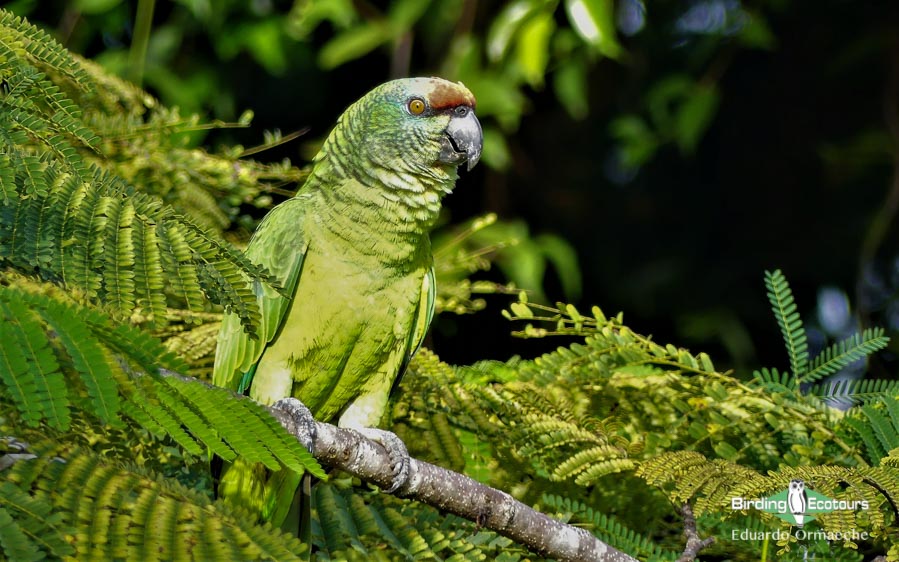
Day 3. Kaieteur Falls – Surama Eco-Lodge
After breakfast at our hotel we will take a chartered flight over unspoiled pristine forest to Kaieteur Falls, the world’s highest free-falling waterfall. Though Venezuela’s Angel Falls is greater in total height, its filamentous drop occurs in stages, whereas Kaieteur Falls is a single, massive, thundering cascade 330 feet (100 meters) wide, as the Potaro River makes a sheer drop of 750 feet (228 meters), nearly five times the height of Niagara Falls. The spectacle is even more impressive due to its remoteness – it is entirely possible that we will be the only people viewing the falls during our visit. Here we hope to find White-chinned and White-tipped Swifts swirling over the gorge. The other two targets are the astonishingly colorful Guianan Cock-of-the-rock and the most-wanted Orange-breasted Falcon. We should also be able to find the rare and endemic Beebe’s Rocket Frog that lives in water held in the leaves of giant bromeliad plants.
Afterwards our chartered flight will take us to Fairview village, from where we will be transferred to Surama Eco-Lodge in the heart of Guyana’s beautiful rainforest. Arriving at the lodge by 3 p.m., we will settle into our accommodation and should have time to look for some classic and common species around the lodge grounds before it gets dark. When darkness falls, this will be our first opportunity to look for Tawny-bellied Screech Owl and other species of nightjars including Pauraque, White-tailed Nightjar and Short-tailed Nighthawk.
Overnight: Surama Eco-Lodge
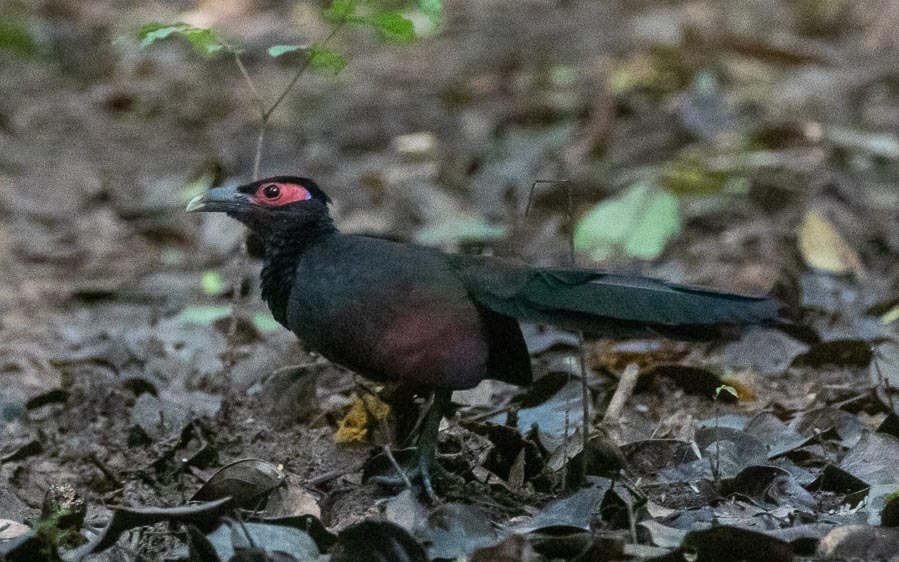
Days 4-5. Birding Surama Eco-Lodge
We will spend the next two full days exploring the forest interior of Surama Eco-Lodge looking for specials such as Black-faced Hawk, White-bellied Antbird, Cream-colored, Ringed, and Waved Woodpeckers, Guianan Puffbird, Caica Parrot, Spix’s Guan, Little Chachalaca, Red-and-green Macaw, White-crowned Manakin, Black-crested Antshrike, Rufous-bellied, Long-winged, and White-flanked Antwrens, Helmeted Pygmy Tyrant, Cinnamon-throated, and Wedge-billed Woodcreepers and if we are lucky, we may find the elusive Rufous-winged Ground Cuckoo.
We will spend the afternoons birding some diverse habitats such as forest edge where we could find species such as Ochre-lored Flatbill, Golden-headed Manakin, White-throated Toucan, Red-fan Parrot, Black-necked Aracari, and perhaps even Pompadour Cotinga and Marail Guan. The open grasslands in the area offer chances for Finsch’s Euphonia, Yellow-bellied and Wing-barred Seedeaters, Tropical Gnatcatcher, Green-tailed Goldenthroat, and Savanna Hawk. With some luck we may find the secretive Ash-throated Crake.
Surama Eco-Lodge is also well known for Harpy Eagle which often nest in the vicinity. We hope to find this majestic and most-wanted species, if there are any active nests in the area.
Overnight: Surama Eco-Lodge
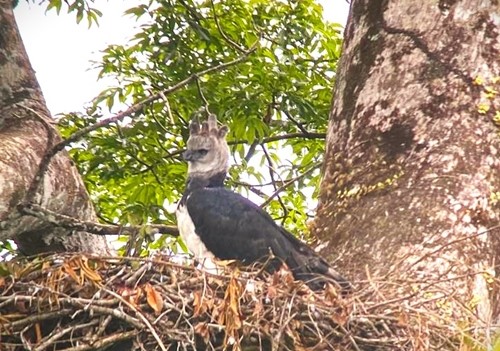
Day 6. Transfer to Atta Rainforest Lodge
Today we will leave Surama Eco-Lodge and head to Atta Rainforest Lodge. Here, the impressive Guianan rainforests protect a unique ecosystem in the heart of the Guiana Shield, where the high species richness of Amazonian and Guianan flora and fauna make it one of the most biodiverse areas in the world. Along the drive we may spot a series of great birds such as Spangled and Pompadour Cotingas, Black-necked Aracari, Red-throated Caracara, Gould’s Toucanet, Blue-throated Piping Guan, Green-backed Trogon, Green Aracari, Black Nunbird, Green-tailed Jacamar, Black-spotted Barbet, Guianan Toucanet, and Black-crowned Tityra, amongst others. We will start looking for our first Crimson Topaz from roads running along blackwater streams in the area.
We will spend three nights at Atta Rainforest Lodge, looking for species such as Black Curassow, Grey-winged Trumpeter, Guianan Toucanet, Guianan Red-necked Cotinga, Capuchinbird, and Spotted Antpitta, amongst other targets. Canopy flocks may also produce Ash-winged, Todd’s, and Spot-tailed Antwrens, Buff-cheeked and Lemon-chested Greenlets, Olive-green and Guianan Tyrannulets, Zimmer’s Flatbill, Yellow-throated Flycatcher, and Guianan Puffbird. Before arriving at our lodge, we will look for Rufous Potoo and if any birds are at their day roosts, we will be able to enjoy this very rare and elusive bird.
Overnight: Atta Rainforest Lodge
Days 7-8. Atta Rainforest Lodge
We will have two full days to explore the forests around Atta from which we will visit the canopy walkway to look for passing flocks of canopy-dwelling species. Time will be spent looking for Todd’s and Spot-tailed Antwrens, Short-tailed Pygmy Tyrant, Guianan Toucanet, Green Aracari, Painted Parakeet, Screaming Piha, Black-headed Parrot, Guianan Puffbird, Guianan Trogon, Dusky Purpletuft, Paradise and Opal-rumped Tanagers, Golden-sided Euphonia, and Black Nunbird. The entire morning will involve birding from the canopy walkway and walking the trails around the lodge. This wonderful area is famous for its variety of colorful cotingas, and if we can locate a few fruiting trees, we will be in for an avian spectacle with possibilities of Pompadour, Purple-breasted, and Guianan Red-necked Cotingas as well as the most-wanted Crimson Fruitcrow. The forest interior is our best bet for Grey-winged Trumpeter, Amazonian Barred and Red-billed Woodcreepers, Helmeted Pygmy Tyrant, Ferruginous-backed Antbird, Waved, Chestnut and Red-necked Woodpeckers, as well as Guiana Spider Monkey and White-faced Saki.
The white-sand forest patches are good habitat to look for Black Manakin, Red-billed Woodcreeper, Guianan Streaked Antwren, Amazonian and Mouse-colored Antshrikes, and Black-chinned, and Grey Antbirds. Other interesting birds to look for here include Rufous-bellied Antwren, Collared Puffbird, White-throated Manakin, Cinnamon-crested Spadebill, Common Scale-backed, White-plumed, Ferruginous-backed and Rufous-throated Antbirds.
At night we will look for the localized White-winged Potoo which is one of the targets for this area as well as Amazonian Pygmy Owl, and Crested and Black-and-white Owls.
Overnight: Atta Rainforest Lodge
Day 9. Atta Lodge to Rock View Lodge – Northern Rupununi
Before leaving the lodge, we will have a final morning’s birding session around the lodge, scanning the treetops looking for Marail Guan, Green Aracari, Guianan Puffbird, Dusky Purpletuft, Black-spotted Barbet, Golden-collared Woodpecker, Black-bellied Cuckoo, Green Oropendola, and Crimson Fruitcrow.
After breakfast we will depart for Rock View Lodge, with our journey taking us across the North Rupununi Savannah. The road skirts numerous gallery forests and wetlands, offering great views of a variety of herons, ducks, Jabiru, Pinnated Bittern, Plumbeous and Grey Seedeaters, Bicolored Wren, Grassland Yellow Finch, Yellowish Pipit, White-fringed Antwren, Crested Bobwhite, Green-rumped Parrotlet, the colorful Orange-backed Troupial, and Double-striped Thick-knee. On the drive we will make several stops to look for Crested Doradito and Bearded Tachuri, two key species on our target list. This is also the best chance of finding Giant Anteater – we have a high success rate of spotting these most-wanted and bizarre animals on our tours. We will then continue our journey to Rock View Lodge, where we hope to arrive early in the afternoon in time for check in and our dinner.
Overnight: Rock View Lodge
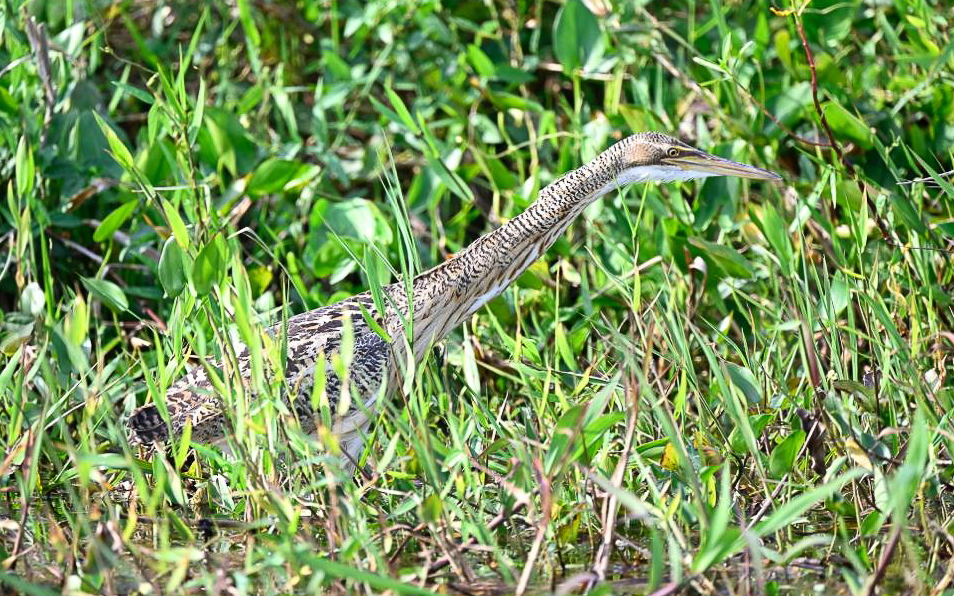
Day 10. Rock View Lodge birding and Rupununi River excursion
The morning will start with a cup of coffee before heading out by boat on the Rupununi River. We will be in small engine-powered boats as we head downstream. Depending on the water level we will visit some of the many oxbow lakes found in the area and focus on seeing the rare Crestless Curassow – our best chances of seeing this bird are along the river banks as the birds come to drink in the morning. We are also likely to find Green-and-rufous and Amazon Kingfishers, Rufescent Tiger Heron, Agami, Boat-billed and Capped Herons, Sungrebe, Sunbittern, Pied Plover, Bare-necked Fruitcrow, and Spot-breasted Woodpecker. In addition, we may be lucky enough to see Giant Otter, Capybara, Black Caiman, Spectacled Caiman, and many species of monkeys. Afterwards, we will return for lunch back at the lodge.
In the late afternoon, as the temperature cools down, we will visit a nearby gallery forest to look for White-tailed Nightjar, Spot-tailed Nightjar, and Rufous Nightjar. This is also a good opportunity to see hundreds of Least and Lesser Nighthawks as they feed at dusk.
Overnight: Rock View Lodge
Day 11. Rock View Lodge to Karasabai Village
Moving on, today we head for Karasabai village, a distant border village perched between the northern Rupununi Savannah and Pakaraima Mountains along the Brazilian border. Here we are delighted to have the rare opportunity to see the Endangered Sun Parakeet. In the early 1990s this species was on the brink of extinction due to extreme pressure from the pet trade, at which point local villagers took aggressive action to rehabilitate the population. Down to a mere seven individuals, conservation efforts have battled to regain their former numbers, but signs are hopeful, and the current population census suggests that at least 300 birds are thriving in the area today. Karasabai Village is well off the standard tourist track, offering a government guesthouse with adequate but sparse accommodations for our group. Nonetheless, local hospitality reigns, and when not on the trail looking for Sun Parakeet we’ll have a great opportunity to meet and interact with an Amerindian community that sees very few tourists and is eager to share their stories and learn about a world outside of their own. We will see plenty of other species during the day, but our focus will be on finding and observing this gorgeous parakeet. After seeing the Sun Parakeet we will enjoy a delightful lunch before departing Karasabai village in the afternoon and continue to Manari Ranch near the town of Lethem.
Overnight: Manari Ranch, Lethem
The beautiful and rare Sun Parakeet (photo John Christian).
Day 12. Full day looking for Red Siskin
Today we leave the lodge very early at 3 a.m. in our 4×4 vehicles and drive roughly 55 miles (90 kilometers) southeast of Lethem. The drive will take us about six hours depending on what we see along the way. The ‘road’ is a traffic-less sandy track meandering through the hilly savannas, with many opportunities for spontaneous birdwatching stops. Along the way, we may scan numerous wetland areas for Maguari Stork, Brazilian Teal, White-tailed Hawk, Double-striped Thick-knee, and Bearded Tachuri. We will also pass the Amerindian communities of St. Ignatius and Shulinab, where the traditional homes and lifestyles of Amerindian Guyana are on display and remind us just how different their lives are. We will meet one of our local guides who has been studying the rare and localized Red Siskin, a bird only discovered in Guyana in 2000 and one of the holy grails of South American ornithology.
Red Siskin will be our target southeast of Lethem (photo John Christian).
Apart from the magnificent Red Siskin we will look for Pale-bellied Tyrant-Manakin and Sharp-tailed Ibis – both are most-wanted species, so our efforts will be concentrated on seeing these special birds, although many other species will be seen while searching for these targets. In the surrounding areas we could also find Little Chachalaca, Black-collared Hawk, Amazonian Scrub Flycatcher, Plain-crested Elaenia, Pale-tipped Inezia, Brown-crested and Vermilion Flycatchers, White-naped Xenopsaris, Burnished Buff Tanager, Rufous-browed Peppershrike, Tropical Gnatcatcher, Glittering-throated Emerald, Ashy-headed Greenlet, Hooded Tanager, and Flavescent Warbler. We will enjoy a delightful lunch at Dadanawa Ranch before making our way back across the savanna to Manari Ranch.
Overnight: Manari Ranch, Lethem
Day 13. Takutu and Ireng Rivers excursion, flight to Georgetown
Another early morning start will see us leaving our delightful base to access the dry scrub and savanna alongside the Takutu and Ireng Rivers. Once again, our 4×4 vehicles will come into play as we must get to an area where two highly restricted and poorly known species occur, namely Hoary-throated Spinetail, and Rio Branco Antbird. We will explore wetlands as well as the dry desert for a variety of species such as Pinnated Bittern, Black-bellied Whistling Duck, Masked Duck, Maguari Stork, Double-striped Thick-knee, South American Snipe, Pied-billed and Least Grebes, Crested Bobwhite, Pearl and White-tailed Kites, Savanna Hawk, Aplomado Falcon, Brown-throated Parakeet, Red-bellied Macaw, Pale-legged Hornero, Fork-tailed Palm Swift, Sooty-capped Hermit, White-tailed Goldenthroat, Rufous-tailed Jacamar, White-bellied Piculet, Black-crested and Barred Antshrikes, Mouse-colored Tyrannulet, Yellow-olive and Ochre-lored Flatbills, Vermilion, Short-crested, and Fork-tailed Flycatchers, Yellowish Pipit, and Orange-backed Troupial. With two exceptionally rare birds hopefully under our belts, we will return to our lodge for lunch. After lunch we will head to the Lethem Airport to board our flight to Georgetown.
Overnight: Georgetown
Day 14. Georgetown, your international flight home.
Today you will be escorted to the international airport to connect with your flight home.
Please note that the itinerary cannot be guaranteed as it is only a rough guide and can be changed (usually slightly) due to factors such as availability of accommodation, updated information on the state of accommodation, roads, or birding sites, the discretion of the guides and other factors. In addition, we sometimes must use a different international guide from the one advertised due to tour scheduling.
Download ItineraryGuyana: The Lost World Tour Tour Report, January 2024
21 JANUARY – 3 FEBRUARY 2024
By Eduardo Ormaeche
DOWNLOAD TRIP REPORT

Guianan Cock-of-the-rock (photo Sue Bryan).
Overview
I had the privilege of leading a Guyana birding tour from 21 January to 03 February 2024. The five wonderful participants were absolutely keen on birds and wildlife and very enthusiastic about our adventure exploring this little-visited South American country.
Our two-week birding adventure began by visiting the coast at Georgetown to look for some special birds such as Scarlet Ibis, Rufous Crab Hawk, Blood-colored Woodpecker, White-bellied Piculet, and Festive Amazon.
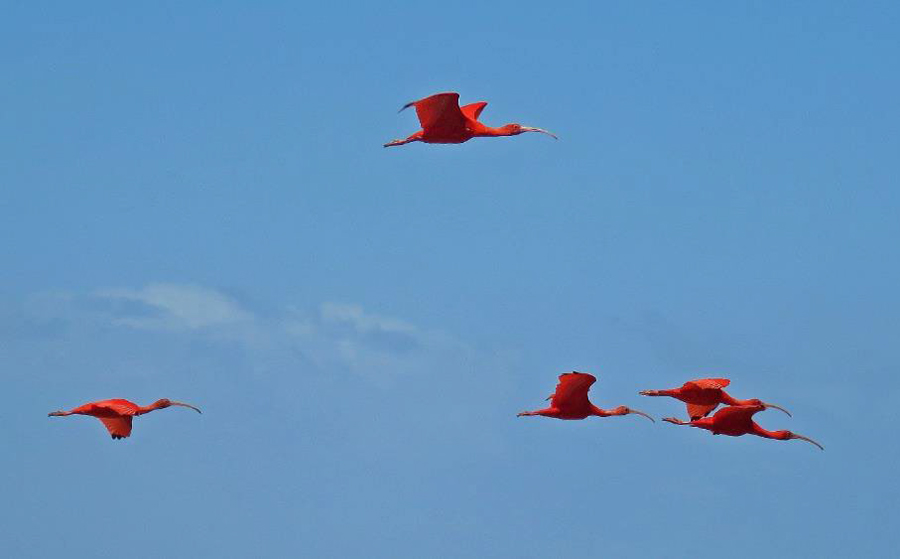
Scarlet Ibis flying along the coast (photo John Geeson).
We then flew to (and above) Kaieteur Falls, an amazing waterfall with a single drop of 741 feet (226 meters) – higher than either Niagara or Victoria Falls – but less well-known. This was an amazing place to start the trip. We could see the highlands of Guyana below, which are totally inaccessible, enjoy the dramatic scenery, and appreciate the pristine rainforest. Nevertheless, we were saddened by the threat of “progress”. Large deposits of gold, diamonds, bauxite and crude oil (from the ocean) increased Guyana’s GDP by 43% in 2020. Everything seems to indicate that Guyana’s economy is on a firm upward trend, hopefully the pristine rainforest will be cherished, valued and preserved.
In the rainforest we had fabulous encounters with species such as Pompadour Cotinga, Capuchinbird, Guianan Red Cotinga, Guianan Cock-of-the-rock, Red-fan Parrot, Black Curassow, Grey-winged Trumpeter, White-winged Potoo, Guianan Toucanet, Guianan Puffbird, Guianan Trogon, Rufous-throated Antbird, Waved Woodpecker, White-plumed Antbird and Rufous-winged Ground Cuckoo.
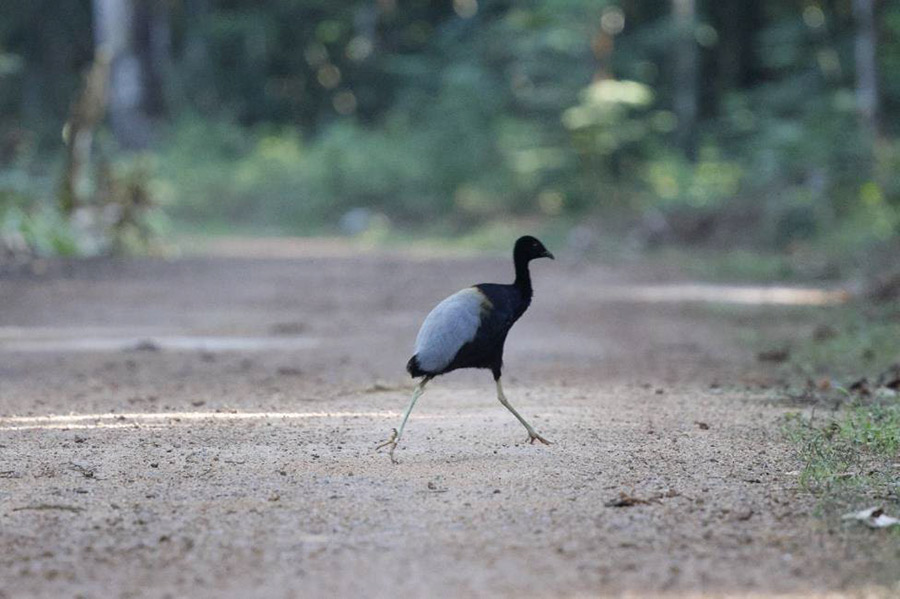
Grey-winged Trumpeter near Iwokrama River Lodge (photo Sue Bryan).
We then moved on to the savanna, a part of the country which has even fewer foreign visitors. Here, we saw some highly threatened species, considered among the rarest on the continent, such as Red Siskin, Sun Parakeet, Rio Branco Antbird, Hoary-crested Spinetail. Other specials included Bearded Tachuri, Crested Doradito and Least Nighthawk.
This tour had it all; charter flights above unbroken forest, walks in the rainforest interior, canopy walkways through the treetops, boat rides and 4×4 drives. It was so much fun and a great adventure!
Detailed Report
Day 1, 21st January 2024. Arrival in Georgetown and transfer to Cara Lodge
The participants arrived in Georgetown, flying in from Miami and Barbados, and were met by the Birding Ecotours staff. It was a one-hour drive from Cheddi Jagan International Airport to Cara Lodge Hotel. Everyone was excited for our adventure starting the next day.
Day 2, 22nd January 2024. Exploring Mahaica River, Ogle Mud Flats and Guyana Botanical Gardens
After breakfast we went to a small dock to board a boat and explore the Mahaica River, a small river that drains into the Atlantic Ocean. The boat trip was great fun and a good introduction to the birds of Guyana. We managed to see interesting aquatic species such as Yellow-hooded Blackbird, Yellow Oriole, Carib Grackle, Black-capped Donacobius, and Amazon, Green and American Pygmy Kingfishers. Raptors included Black-collared Hawk, Snail Kite, Great Black Hawk and Long-winged Harrier.
Other species proved more difficult, but we managed Silvered Antbird, Coraya Wren, Yellow-chinned Spinetail and bad light did not stop us from enjoying our first Green-tailed Jacamar, although we did get better views later in the trip. We had great views of Guyana’s national bird, Hoatzin, and were rewarded with views of Giant (River) Otter fishing in the peaceful waters of the Mahaica River. Other species included Lesser Yellow-headed Vulture, Green Ibis, Striated Heron, Snowy Egret, Tricolored and Little Blue Herons, Great Egret, Limpkin, Southern Lapwing, Yellow-crowned and Orange-winged Amazons, Blue-and-yellow Macaw, Brown-throated Parakeet, Bat Falcon, Laughing Falcon, Lineated Woodpecker, a glimpse of Little Cuckoo (the only sighting of the trip), Cayenne Jay, White-winged Swallow and Grey-breasted Martin.
Back on the mainland, we had a great time checking the Ogle Mud Flats, where we had amazing views of the most-wanted Scarlet Ibis, as well as other interesting species like Semipalmated Plover, Spotted and Solitary Sandpipers, Greater and Lesser Yellowlegs, Willet and Hudsonian Whimbrel. In addition to these birds, we found Black-crowned and Yellow-crowned Night Herons, Tricolored Heron, Black Skimmer, Royal Tern and Brown Pelican. We also suddenly had a glimpse of a Small Indian Mongoose (introduced to Guyana and the Caribbean in the 19th century) amongst the mangroves.
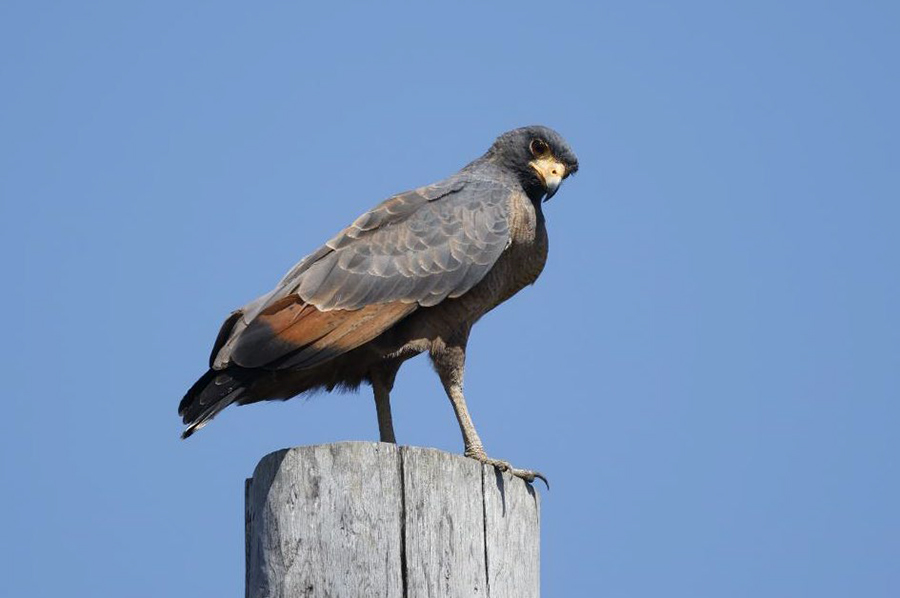
Rufous Crab Hawk (photo Sue Bryan).
We enjoyed the views of the Atlantic shores, with the mudflats and the mangroves giving way to the city – where modern buildings stand next to typical colonial architecture – in the background. We left this area to try for Mangrove Rail, which was unfortunately not around today, and hot weather soon started, without mercy. We then had a brilliant encounter with the localized Rufous Crab Hawk, an important bird in this part of the country. We also had nice views of Pearl Kite, as always, lovely to see through the scope. We then returned to our hotel for a rest during the heat of the day.
In the afternoon we had an incredible time in Guyana Botanical Gardens in Georgetown, starting with common species such as Ruddy Ground Dove, Smooth-billed Ani, Plumbeous Kite, Yellow-headed Caracara, Great and Lesser Kiskadees, Black-capped Donacobius, Palm and Blue-grey Tanagers, and the only Turquoise Tanager of the trip. Other species included Blue-black Grassquit, Wing-barred Seedeater, Red-legged Honeycreeper, Pale-breasted Thrush, Common Tody-Flycatcher, Rusty-margined Flycatcher, Cinereous Becard, Straight-billed Woodcreeper, Peregrine Falcon, Brown-throated Parakeet, Black-necked Aracari, Toco Toucan (the largest toucan in the world) and many Orange-winged Amazons. Red-shouldered Macaw produced great excitement, especially when enjoyed through the scope, and even though it took some time, we managed to find Festive Amazon, which we had sadly missed on our 2023 trip.
The gardens were very productive in the afternoon, revealing Straight-billed Woodcreeper, Grey Kingbird, Snail Kite and, of course, two of the main targets of the day, White-bellied Piculet and the most-wanted Blood-colored Woodpecker, which is restricted to the coast of Guyana and Surinam. With all these great sightings we returned to our hotel, after a very long day in the field. Here, we had some sightings of Guianan Brown Capuchin.
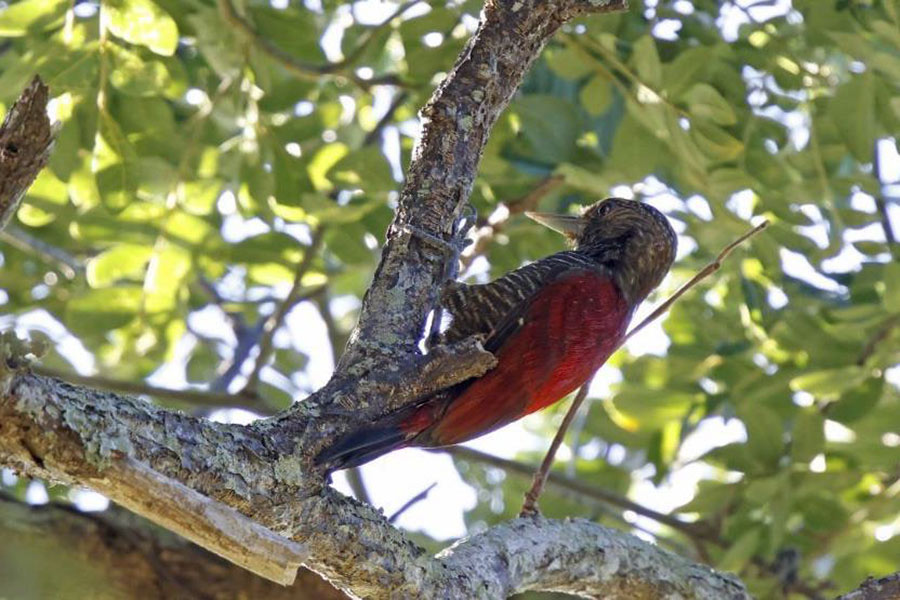
Blood-colored Woodpecker seen at the botanical garden (photo Sue Bryan).
Day 3, 23rd January 2024. Flight to Kaieteur Falls and Surama Eco-Lodge
We started the day with Plain-bellied Emerald in the lodge grounds before transferring to the domestic airport to catch our charter flight to Kaieteur Falls. After an easy flight, we landed at Kaieteur National Park and were fascinated by the incredible geography of this unique place, surrounded by table-like mountains – tepuis. We excitedly anticipated all the key localized species found only in the inaccessible Guyana highlands.
We started hiking to the first viewpoint, birding along the way and found Rufous-crowned Elaenia, Swallow and Silver-beaked Tanagers, Blue Dacnis, Green Honeycreeper, Tropical Kingbird, Cayenne Jay, Forest Elaenia and Black-tailed Tityra. Only a few of us got to glimpse the male Red-shouldered Tanager, which soon disappeared into the bushes, never to be seen again.
We arrived at the impressive waterfall viewpoint and, after taking photos and enjoying the incredible natural beauty, we managed to find an Orange-breasted Falcon hunting along the lowest parts of the waterfall. It was a stunning sighting of this rare and patchily distributed species. We also enjoyed views of White-tipped Swift and Cliff Flycatcher.
The final two sightings here included nice views of the handsome Guianan Cock-of-the-rock, which showed well, and Golden Frog, an Endangered Guyana endemic, with its distribution centered around Kaieteur Falls. This tiny frog is found only on the giant bromeliads of the genus Brocchinia,which are common in the area.
We then took the 30-minute flight to Surama Eco-Lodge, landed on the local airstrip and were picked up by our main driver for the rest of the trip, who transferred us to the lodge. After check-in we managed to do some birding in pleasant surroundings which provided species like Pale-vented Pigeon, Ruddy Ground Dove, Green Ibis, Savanna Hawk, Plumbeous Kite, Great Black Hawk, Neotropical Palm Swift, Blue-headed Parrot and Red-and-green Macaw, which always look spectacular flying above the vast tropical forest. Other birds included Great Potoo (at its day roost), Forest and Plain-crested Elaenias, Crested Oropendola, Swallow-winged Puffbird, Blue-grey and Palm Tanagers (nesting under the cabin rooms) and, before dusk, we had Lesser Nighthawk flying above the Surama Lodge clearing. After supper we went to bed in preparation for tomorrow’s forest interior birding.
Day 4, 24th January 2024. Full day at Surama Eco-Lodge
We started the day watching some open country species such as Scaled Pigeon and White-tipped Dove, before entering the forest and enjoying our first encounter with Great Tinamou, crossing the trail in front of us. We had a great morning, despite the dry conditions of the forest. We managed to find White-crowned Manakin, Green-backed Trogon, Guianan Trogon, Guianan Puffbird, Great Jacamar, Paradise Jacamar, Black Nunbird, Grey-headed Kite, Green Aracari, White-throated Toucan, Lineated and Cream-colored Woodpecker, Channel-billed Toucan, Golden-winged Parakeet and Red-throated Caracara.
We arrived in an area where army ant swarms are often found, and where we had an incredible encounter with two Rufous-winged Ground Cuckoos in 2023. We found the army ant swarm and found Rufous-throated Antbird, the iconic White-plumed Antbird, Plain-brown Woodcreeper, Black-chinned Antbird and, in the middle of a mixed feeding flock frenzy, John had a glimpse of the most-wanted Rufous-winged Ground Cuckoo, which sadly immediately disappeared behind a log. The ants retreated and the bird activity was over, nevertheless, we continued doing our best to find more species, always hoping to find the ground cuckoo once more. This may sound unrealistic, but it is possible in Guyana, the best place to see this species.
In the evening, we found more species, including Amazonian Barred Woodcreeper, Black-tailed Tityra, Ruddy-tailed Flycatcher, Yellow-bellied and Forest Elaenias, Piratic Flycatcher (near the oropendola nests), Green Oropendola, Red-rumped Cacique, Scarlet Macaw, White-throated Toucan, Orange-winged Amazon, Brown-throated Parakeet, a female Tufted Coquette, and Buff-throated Woodcreeper. The grassland around the lodge provided nice views of Wedge-tailed Grass Finch.
In the evening, we tried for Spectacled Owl and Tawny-bellied Screech Owl, both of which showed well. Additionally, we heard Crested Owl and Amazonian Pygmy Owl.
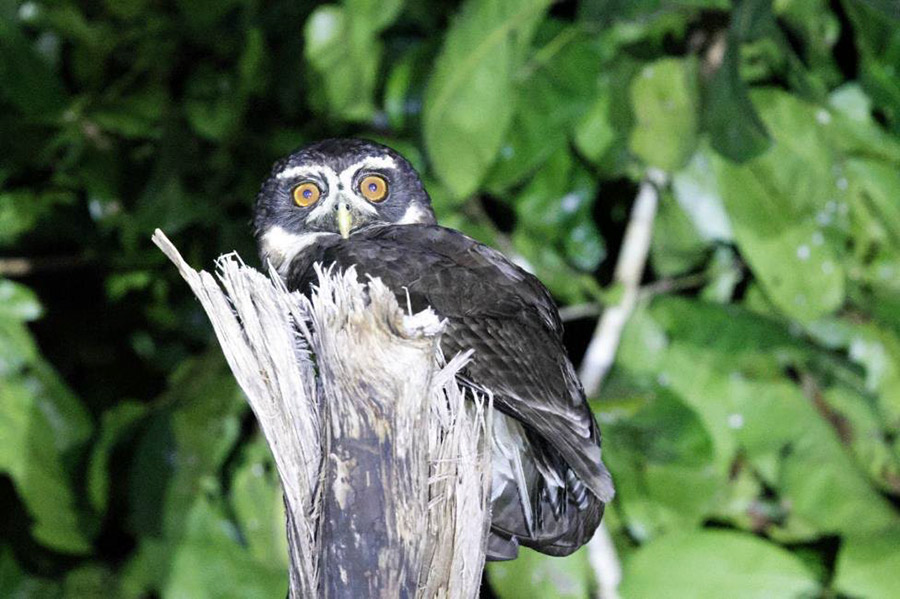
Spectacled Owl at Surama Eco-Lodge (photo Sue Bryan).
Day 5, 25th January 2024. Birding around Surama and transfer to Iwokrama Lodge
We started the day by visiting a forested swampy area where the shy and secretive Zigzag Heron had been seen recently. We arrived at the site as quietly as possible and, after some effort and patience, we managed to get splendid views of this nocturnal and poorly known species, for everybody’s enjoyment.
After this incredible sighting, we returned to the lodge for breakfast. We then explored some forest trails around Surama, before leaving for Iwokrama Lodge. We had a great morning finding species such as Painted Parakeet, Blue-and-yellow and Red-and-green Macaws, Epaulet Oriole, Helmeted Pygmy Tyrant, and Caica and Blue-headed Parrots giving fly-by views. After some forest walking, we managed to find another army ant swarm and decided to try for Rufous-winged Ground Cuckoo. It didn’t take long before we heard the bird approaching, with the characteristic bill-clapping sound, giving everyone goosebumps. Sadly, the individual was very cautious and proved secretive, keeping its distance between foliage and forest floor trunks. Nevertheless, most of us managed to get full views, or at least the full head, before it became aware of us and disappeared, not to be seen again on this tour. Other interesting species included Black-chinned Antbird, Wedge-billed Woodcreeper, Northern Slaty and Cinereous Antshrikes, Rufous-bellied Antwren, and Grey and Ferruginous-backed Antbirds.
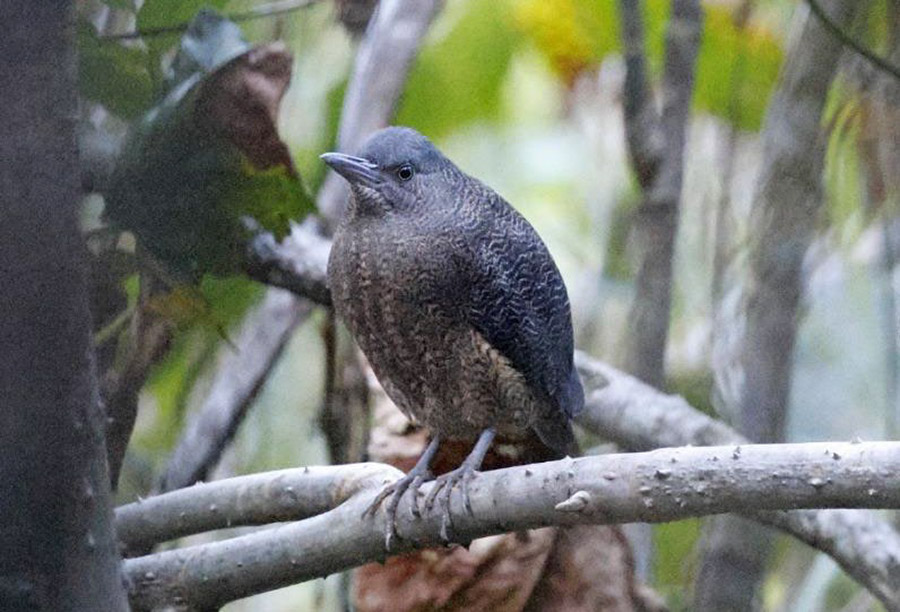
The secretive Zigzag Heron was a nice surprise on our Guyana birding trip (photo Sue Bryan).
We left the general area and drove towards our next destination, Iwokrama River Lodge. As I looked at the progress of the construction of the road that will join Lethan, on the Brazilian border, with Georgetown, I wondered how this will affect the birds and wildlife that inhabit this undisturbed forest. Sadly, the amount of traffic has already increased significantly compared to last year’s tour. The good thing is that the road is closed at 5pm every afternoon, and that might help alleviate nocturnal species being disturbed and becoming roadkill.
Along the drive we saw Greater Yellow-headed Vulture, Swallow-tailed Kite, Crested Oropendola and Rufescent Tiger Heron. We arrived at Iwokrama for lunch and enjoyed the beautiful setting next to the Essequibo River, a nice change from all the other lodges, which are surrounded by forest or haciendas. We spent the afternoon birding around the lodge, finding Chestnut-bellied Seedeater, Rufous-throated Sapphire, Fasciated Antshrike, Guianan Streaked Antwren, and Green Honeycreeper, and we scored with the most-wanted Grey-rumped Trumpeter. Trumpeters are part of a family containing only three species in the entire world.
Day 6, 26th January 2024. Turtle Mountain and Boat River
Today we planned to explore the lower and mid portions of Turtle Mountain, for which we split the group into two boats for a 20-minute boat ride and, after reaching the base of the trail, we started the hike together. Activity was very low, starting with views of Spix’s Guan, Guianan Trogon, Red-necked Woodpecker, Black Caracara, Grey-rumped Swift, Bat Falcon, Plumbeous Kite, Black Nunbird, Reddish Hermit, Blue-headed Parrot, Blue-and-yellow Macaw, and other usual suspects. We found a large army ant swarm, but with no birds attending, eventually we encountered a large group of White-lipped Peccaries which gave us the full performance. This was one of our quietest mornings in Guyana. Hot and dry, we returned to the lodge to rest and take another boat trip in the afternoon.
The boat trip was very nice, with a welcome breeze and aquatic species such as Black-collared Swallow, Muscovy Duck, Pied Plover, Spotted Sandpiper, Southern Lapwing, Anhinga, Large-billed and Yellow-billed Terns, Neotropic Cormorant, Cocoi Heron, Green Ibis, White-winged Swallow, Amazon and Green Kingfishers and, before dusk, Ladder-tailed Nightjar (male and female) and Boat-billed Heron.
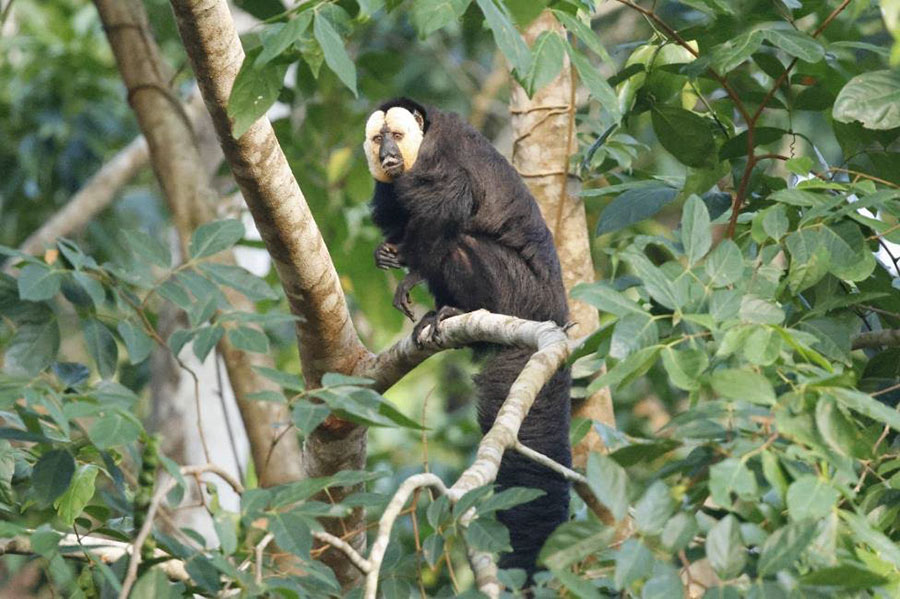
We had a great encounter with the uncommon White-faced Saki at Iwokrama River Lodge (photo Sue Bryan).
Day 7, 27th January 2024. Birding en route to Atta Lodge
This was our last day around Iwokrama, and as we walked around the lodge clearing, we found the usual suspects, along with a Ringed Woodpecker playing hide and seek with us. On our way out we found the amazing White-faced Saki (also called Guianan Saki), which is restricted to northeast South America.
Birding the road to Atta Lodge provided great birds, including Spangled Cotinga, Bronzy Jacamar, Crimson-crested Woodpecker, Sunbittern, Capped Heron, King Vulture, Grey-lined Hawk, Ringed Kingfisher and Swallow-tailed Kite, with the other amazing sighting being the stunning Pompadour Cotinga (male and female) feeding in the same tree as Spangled Cotinga and Green Aracari.
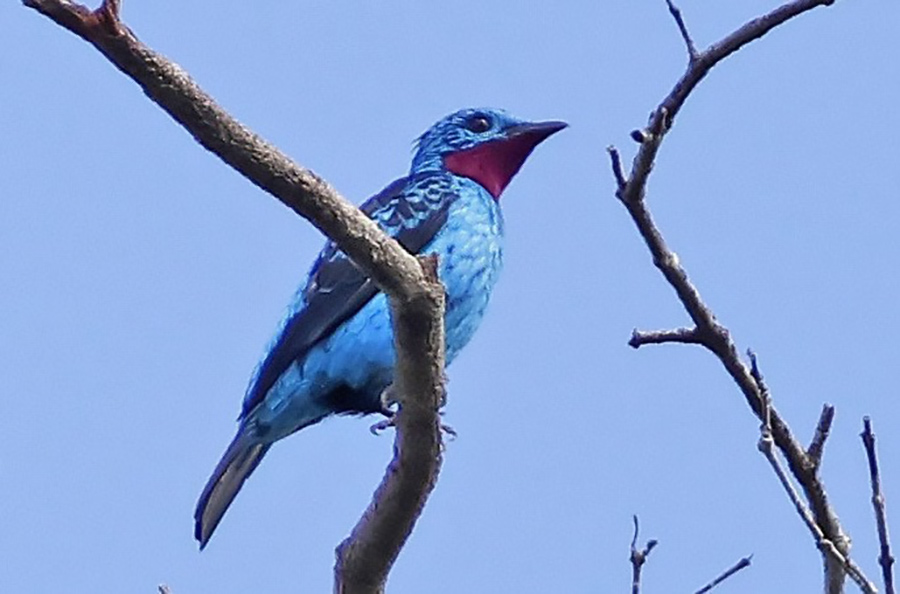
Spangled Cotinga along the Atta Road (photo Sue Bryan).
The rest of the afternoon was quiet. We, however, found Grey-breasted Sabrewing, Long-tailed Hermit, Fork-tailed Woodnymph, Black-necked Aracari, Green Oropendola, Channel-billed Toucan, Red-necked Woodpecker, Red-throated Caracara, Golden-winged Parakeet, Blue-cheeked Parrot, Southern Mealy Amazon, Purple-throated Fruitcrow, the localized Black-faced Hawk and the diminutive Golden-headed Manakin, which was found on one of the white sand forest trails, where we also saw Bronzy Jacamar.
When we reached Atta lodge, we were given the bad news that the once-reliable Crimson Fruitcrow had not been seen for several days. Despite considerable effort we could not find any during our stay or along the drive out of the rainforest which turned out to be the only Guyana special that we were unable to find on the trip. In the evening we tried for White-winged Potoo, which came into view, as did Short-tailed Nighthawk, but we only heard the scarcer Common Potoo.
Day 8, 28th January 2024. Birding Atta Canopy Walkway
We had a predawn start under the spectacular stars, with the Pleidaes visible next to Orion, and the peaceful Atta rainforest embracing us, as we craved a cup of coffee. There weren’t any owls calling around the clearing this morning, except for the very distant call of Amazonian Pygmy Owl, which proved difficult to see this year. The sounds of the rainforest changed, from the pygmy owl to howler monkeys, then parrots and macaws, merging into a vast chorus of several species of birds, becoming a single sound that marked the beginning of a new morning. We were looking forward to visiting the famous Canopy Walkway at Atta.
Hoping for the best, we hiked up the trail to the canopy, finding no activity in the understory. We crossed the suspension bridges and reached the platforms, where we had our first encounter with the widespread Guianan Weeper Capuchin. One of the main targets, Guianan Toucanet (a localized Selenidera from northern South America) was quickly spotted. In addition, we had Black-eared Fairy, which is regularly seen feeding in the tree canopy. We also saw Green-backed and Guianan Trogons, Guianan Puffbird, Black Nunbird, Blue-cheeked Parrot, Red-and-green Macaw, Black-spotted Barbet and a female Pompadour Cotinga, but still no Crimson Fruitcrow! Other common species encountered included Southern Mealy Amazon, and Spot-tailed Antwren, which is a canopy special.
On one of the trails, we were delighted to have a long-awaited encounter with the distinctive Capuchinbird, not only seeing the bird but hearing its unique display call. Later in the trip we had another encounter with this species, but it was high in the trees and difficult to photograph.
We decided to go back to the lodge for breakfast and to explore the lodge grounds and the road to Atta. On the way back to the lodge we saw Wedge-billed Woodcreeper, Screaming Piha and the most-wanted Red-and-black Grosbeak, a fantastic encounter! After breakfast, which was served by the lodge’s friendly staff, we went to explore the entrance road. Again, no sign of the fruitcrow!
Excitingly, we saw a Green Anaconda, well hidden in a flooded area, not far away from the road. This was the second year that I had encountered Green Anaconda in this area! We then had massive flocks of Band-rumped and Grey-rumped Swifts, as well as Plumbeous Pigeon, King Vulture, Paradise and Green-tailed Jacamars, Lineated and Ringed Woodpeckers, Yellow-bellied Elaenia, Yellow-throated Flycatcher, Capped Heron and Green Ibis.
In the afternoon we tried for Crimson Topaz along the road, in areas near streams, and searched in every possible place from the moment we arrived at Atta. Our strategy was to play the call and wait for a bit, if it did not show, we would leave and continue birding. We couldn’t even catch a glimpse of it, until the final evening at Atta. The bird responded and landed in a tall tree but took off again so fast that we barely saw the bird in silhouette. Amazingly, Sue managed a photo, in which we could see that it was a male.
Later we explored some of the white sand forest trails that go off from the main road and, after some hard work, we eventually saw one of the main targets in this habitat, the shy Black Manakin. We continued birding along the road and suddenly detected a family of Little Chachalacas (sometimes called Variable Chachalaca by other authorities) crossing the road.
We waited until dusk to try for Black-banded Owl, which came in to the recording and showed nicely, but kept high in the subcanopy where we managed to get great scope views. We also found a Kinkajou watching us from the tops of the Cecropia trees. After a long day, we retreated to the lodge for supper and a good night’s sleep.
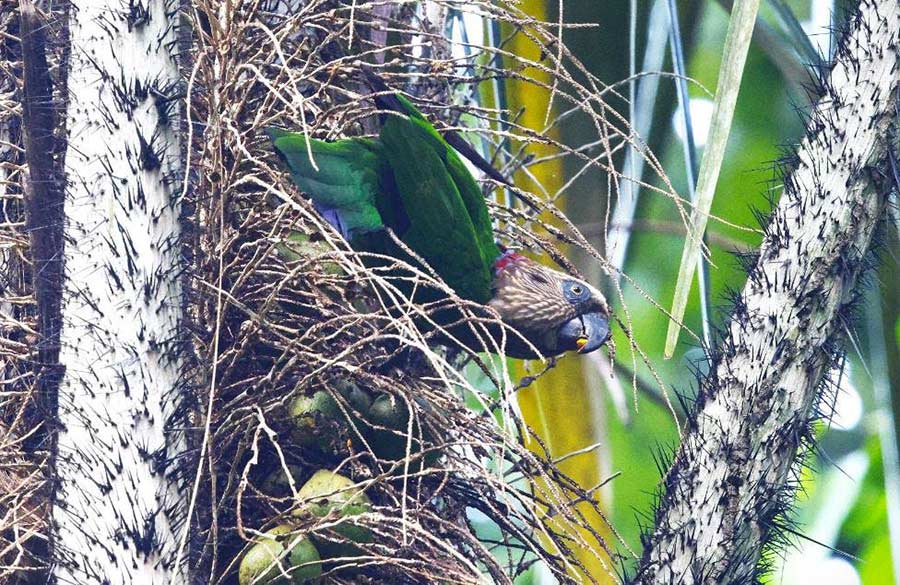
Red-fan Parrots showed very well on our last morning at Atta (photo Sue Bryan).
Day 9, 29th January 2024. Last morning at Atta and transfer to Rock View
We had planned to maximize the first hours of the morning around Atta, before leaving the lodge and the rainforest. We scanned the lodge clearing, looking for Crimson Fruitcrow, which sadly did not show. We heard Guianan Warbling Antbird calling around the clearing, but only a few participants glimpsed it. We hurried from the spot when we heard Red-fan Parrot vocalizing. We found the tree where they were nesting and later had the pleasure of seeing this fantastic species, feeding low on one of the fruiting palm trees around the lodge clearing! This was one of the most-wanted birds for both our Johns and we happily feasted our eyes on these attractive parrots, before they flew away from the lodge.
We continued exploring one of the lodge trails and found the Guianan Red Cotinga, which is one of the most-wanted species in Guyana. They quickly moved under the canopy and were difficult to photograph, so we had to be content just watching this gorgeous bird.
We left the lodge and returned to the Crimson Topaz spot, but there was nobody home today. We continued birding along the road, heading back to Surama Lodge. On the way, we saw Dusky Purpletuft and the only Marail Guan of the trip.
We arrived at the junction with Surama Lodge, where we had an amazing time. We spotted a Black Hawk-Eagle flying high and calling, which flew in closer above the track a couple of times, allowing us to see it in detail. Then we were told that we were close to an area where Ornate Hawk-Eagle had been seen recently and soon we heard the bird calling which we managed to see shortly after. It flew about and perched briefly on one side of the trail, allowing us all to see it well, unfortunately, some branches in front ruined the possibility of good photos.
Ironically, after this hawk-eagle madness, we found a Brown-throated Sloth very close to the trail. There were no new birds after this, except for some more classic sightings, including Greater Yellow-headed Vulture, Swallow-tailed Kite, Yellow-rumped and Red-rumped Caciques, Yellow-headed Caracara, Scaled Pigeon, and Great Kiskadee.
We ate a delicious lunch at the Surama community and then headed to Rock View Lodge, arriving in the heat of the early afternoon. We agreed to rest and then met again at 3 pm to explore the vicinity.
We arrived at a mix of grasslands and wetlands and had a productive couple of hours birding, finding Fork-tailed Flycatcher, Crested Bobwhite, Burnished-buff Tanager, Grey, Ruddy-breasted and Wing-barred Seedeaters, Red-breasted Blackbird, Yellow Oriole, Orange-backed Troupial, Finsch’s Euphonia, Black-capped Donacobius, Barn Swallow, Boat-billed Flycatcher, Lesser Kiskadee, Short-crested Flycatcher, White-headed Marsh Tyrant, Pied Water-Tyrant, Yellow-chinned Spinetail, Northern Mouse-colored Tyrannulet, American Kestrel, Black-collared Hawk, Cocoi Heron, Jabiru, Spotted and Solitary Sandpipers, Common Ground Dove, Green-tailed Goldenthroat and Long-billed Starthroat.
We put a great effort into finding White-naped Xenopsaris, which showed very well for the whole group. Other birds seen at this location included Little Blue Heron, Great and Snowy Egrets, Laughing Falcon, Ringed, Amazon and Green Kingfishers, Wattled Jacana, Green Ibis and Striated Heron.
Just before dusk, we were ecstatic when we saw a couple of Least Nighthawks flying above the fields, still with enough light to see their markings and patterns.
Day 10, 30th January 2024. Essequibo River and birding around Rock View
Unfortunately, several of us had battled to sleep the previous night, due to the intense heat and the fans not being strong enough. However, after an early start, a cup of coffee did wonders to raise our spirits for a day full of adventure. We had a scheduled boat ride on the Rupununi River to look for water species, including the Crestless Curassow.
It didn’t start well as soon after we arrived at the river it started raining, which is not fun on a boat trip. We had two boats and went on the river, hoping the weather would change. It rained, then stopped, then drizzled, then stopped again. With this weather there were not many birds, or at least nothing we had not seen on previous boat trips. The birds we saw this morning included Pale-vented Pigeon, Muscovy Duck, Smooth-billed Ani, Grey-rumped Swift, Limpkin, Large-billed and Yellow-billed Terns, Black Skimmer, Jabiru, Wood Stork, Anhinga, Capped Heron, Black-collared Hawk and Osprey. As we rounded a bend in the river, we suddenly spotted a pair of Crestless Curassow. They were not walking along the sandbars but sitting on a dead tree on the riverbank. We barely saw them before they disappeared, most likely scared by the boats, and sadly not all participants saw them.
We landed on the mainland and tried for some gallery forest birds, such as Black-crested Antshrike, which showed nicely, Coraya Wren, Cinnamon Atilla, Red-capped Cardinal and others. We returned to Rock View in the heat of the day, had lunch and enjoyed some relaxed birding around the property. The afternoon’s easy birding yielded Pale-breasted Thrush, Burnished-buff Tanager and other common species, including Blue-grey and Palm Tanagers. We also took the opportunity to enjoy coffee and cookies, and some cold drinks as well.
Day 11, 31st January 2024. Sun Parakeet and transfer to Manari
Today we took a special trip to explore the deciduous habitats near the Guyana-Brazil border, to look for the endangered Sun Parakeet, one of the targets of this second part of the tour. Sun Parakeets have been caught at a rate of 800,000 per year for the pet trade and are today poorly known in the wild. They have probably been eradicated from French Guyana and are only found in this small portion of Guyana and adjacent Brazil. We arrived and got excited every time we saw a flock of Brown-throated Parakeets. It took a while, but we eventually saw two pairs of Sun Parakeets flying by and landing below the tree tops, before they left to likely join a larger flock – it is usual for flocks to contain around 100 individuals. On the previous year’s tour, we saw more individuals lower down in the trees. We, however, had great scope views, but photography was challenging.
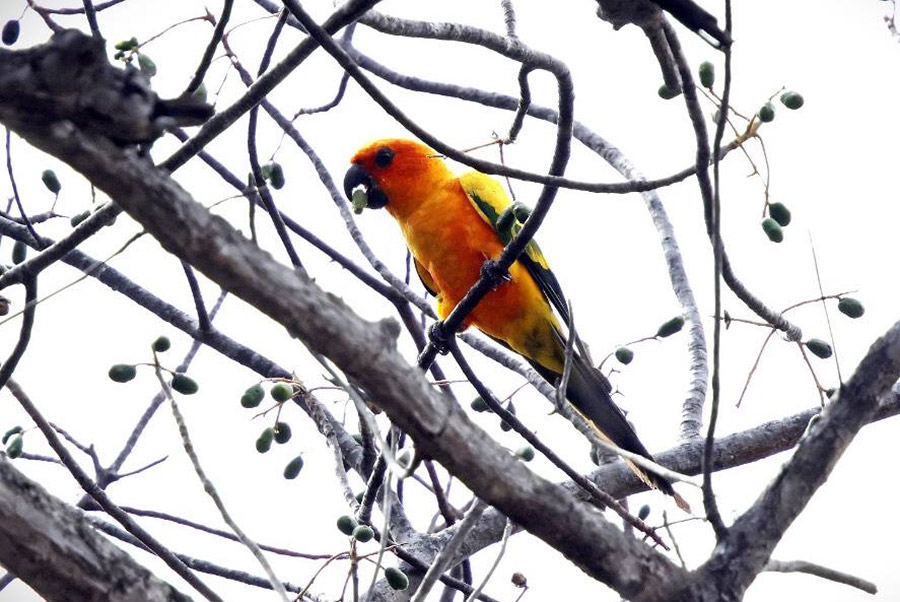
Sun Parakeet was the star in the Manari area (photo Sue Bryan).
In addition, we managed to find Double-striped Thick-knee, Blue-tailed Emerald, Glittering-throated Emerald, Buff-necked Ibis, Common Ground Dove, Crested Bobwhite, Lesser Yellow-headed Vulture, Ferruginous Pygmy Owl, White-barred Piculet, Southern White-fringed Antwren, Streak-headed Woodcreeper, Pale-legged Hornero, Pale-eyed Pygmy Tyrant, Southern Beardless Tyrannulet, Brown-crested Flycatcher, Yellow-bellied Elaenia and Ashy-headed Greenlet.
We then continued our drive towards Manari, our base for the next two nights. Along the way we spotted Wedge-tailed Grass Finch, Grassland Sparrow, Yellowish Pipit, Eastern Meadowlark and Grey Seedeater. We made a stop to look for another grassland target in the Rupununi area, the Crested Doradito. We persevered, in the intense heat of the day, searching for this little skulker. Thankfully, we were fortunate to find an individual, as the habitat was untouched in this particular area, whilst other suitable and known habitat had been burned by fires during this unusually dry season.
In the afternoon we hung around the hotel grounds, finding not only some common species, but also our first records of Bicolored Wren, American Yellow Warbler, Burnished-buff Tanager, Olive-grey Saltator, Yellow-bellied and Lesser Elaenias and Common Tody-Flycatcher.
Manari Ranch was very hot, although the food was good, and there was lime and watermelon juice continually available. We also took advantage of the “few quiet moments of the trip” to relax and enjoy other refreshments – at sundown some participants discovered that the Guyanese rum was particularly good.
We retired early to our rooms, immediately after dinner, since a 4 am start was awaiting us the next day. The reason for such an early start was the 4×4 drive to access some Red Siskin habitat, one of the few remaining patches in the world, with arguably the largest known population.
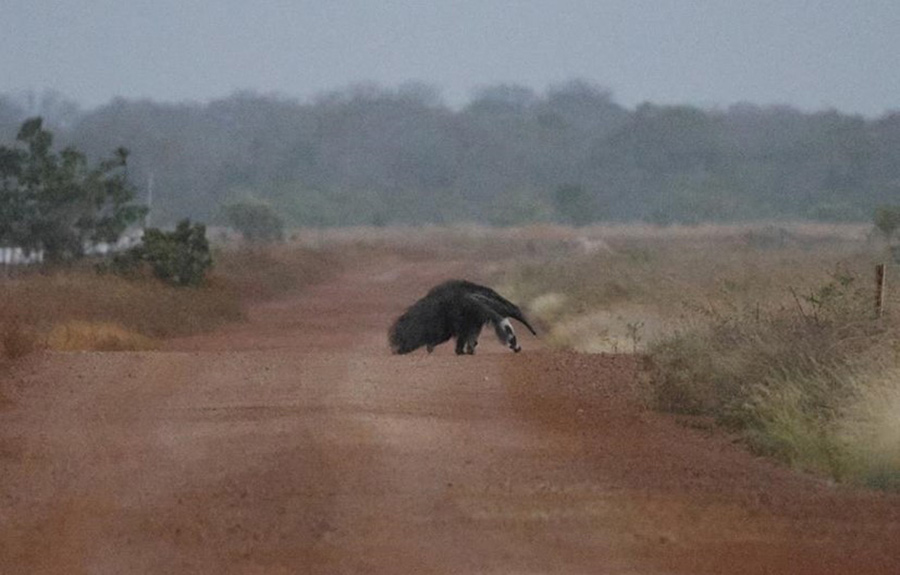
We had a great encounter with a Giant Anteater in the Rupununi savannas (photo Sue Bryan).
Day 12, 1st February 2024. Red Siskin 4×4 vehicle drive and back to Manari
We had a super-early, super-excited start today. After some good, strong coffee, we climbed into the 4×4 vehicles required to reach the habitat of the ultra-rare Red Siskin. We split the group into two vehicles for comfort’s sake and headed out at dawn’s first light. On the main road we had an incredible encounter with a Giant Anteater and saw two more individuals nearby. After a long drive past rivers, streams and amazing scenery, we reached the habitat and, not long after we arrived, we spotted a small flock of Red Siskins, with the most-wanted male sitting out in the open for us. It was brilliant.
Our local guide was Leeroy who is the representative from the local community, and oversees the project for the conservation of Red Siskin and the development of ecotourism in the area. They have done excellent work here and deserve all possible support from those who can assist in improving facilities for tourists to help protect the habitat of the Red Siskin.
No longer under pressure to find the siskin, we wondered what we should do next. We decided to eat our packed breakfast under a roof, on a nice table recently built for visitors. As we were enjoying breakfast, we suddenly saw the same family party flying by again.
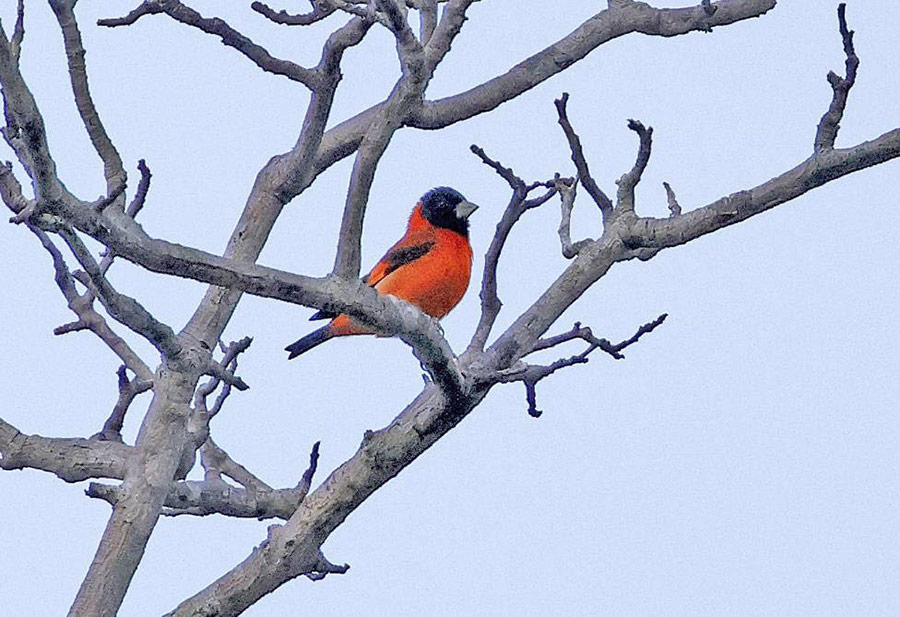
We had amazing views of the Endangered Red Siskin on our Guyana trip (photo Sue Bryan).
We birded the surroundings, finding pretty much the same common species, so we left and spent more time on the habitats and ponds on the way back. We did well, finding Hooded Tanager, Spotted Puffbird, Hepatic Tanager, Orange-backed Troupial, Grassland Sparrow, Cayenne Jay, Black-crested Antshrike, Lesser Yellow-headed Vulture, Buff-necked Ibis, Common Ground Dove and Crested Bobwhite. An interesting observation through the scope was a juvenile King Vulture. We then encountered Maguari Stork, which was new for the trip, and a superb find in the form of Pinnated Bittern, well camouflaged in the pond’s reeds. Feeling successful, we headed to the community where we had a tasty lunch and, despite the heat of the day, continued towards Manari Ranch.
On the way, we stopped to look for another localized species. We were worried because we saw so many patches of grassland and bushes that had been burned, nevertheless, we did find a couple Bearded Tachuris, which were the cherry on top for the day. We arrived at Manari Ranch and spent the afternoon resting, in preparation for our final day of birding in the area tomorrow. Sadly, our trip was soon coming to an end.
Day 13, 2nd February 2024. Rio Branco and Silver-throated Spinetail, and flight to Georgetown
We had another early start (although not as early as the previous day) and went to explore a mix of habitats between gallery forest and savanna. The main targets were two Critically Endangered species, Rio Branco Antbird and Hoary-throated Spinetail. On the way, we spotted Burrowing Owl, Savanna Hawk, Long-winged Harrier, Common and Ruddy Ground Doves and Buff-necked Ibis.
We started birding in the gallery forest and soon had great views of Rio Branco Antbird. The spinetail was tricky though. We found a pair that were showing fleetingly and were very shy, but we eventually managed fine views of Hoary-throated Spinetail. We also found Spot-breasted and Little Woodpeckers, Brown-crested Flycatcher, Boat-billed Flycatcher, Ashy-headed Greenlet, Northern Mouse-colored Tyrannulet, Glittering-throated Emerald, and Yellow-bellied Elaenia while Rufous-tailed Jacamar was heard only. We tried for Flavescent Warbler, but we could not even hear it today. We started the walk back to the vehicles along which John and Sue saw a Capybara near the river.
We returned to Manari Ranch for lunch, to pack our luggage and transfer to Letham for the commercial flight to Georgetown. We said goodbye to our incredible land crew, especially Gary, and flew to Georgetown. We transferred to Cara Lodge, ate our last meal together and prepared for tomorrow’s early start to be at the international airport three hours before our flight.
I felt a warm and pleasant satisfaction from having led a great group of people, all of whom had vast outdoor experience and who were so enthusiastic about birds and wildlife. The weather had been dry, but we nevertheless got most of our targets and special birds, except the fruitcrow! Everyone was happy, and we had a good reason to come back to Guyana – to tick the fruitcrow!
Thank you very much to the whole group, you were amazing!
Day 14, 3rd February 2024. Transfer to the airport and flight home
The group transferred at different times to the respective airports to connect with their flights home.
Bird List – Following IOC (13.2)
Birds ‘heard only’ are marked with (H) after the common name, all other species were seen.
The following notation after species names is used to show conservation status following BirdLife International: VU = Vulnerable.
| Common Name | Scientific Name |
| Tinamous (Tinamidae) | |
| Great Tinamou | Tinamus major |
| Cinereous Tinamou (H) | Crypturellus cinereus |
| Red-legged Tinamou (H) | Crypturellus erythropus |
| Ducks, Geese, Swans (Anatidae) | |
| Muscovy Duck | Cairina moschata |
| Chachalacas, Curassows, Guans (Cracidae) | |
| Little Chachalaca | Ortalis motmot |
| Marail Guan | Penelope marail |
| Spix’s Guan | Penelope jacquacu |
| Crestless Curassow | Mitu tomentosum |
| Black Curassow – VU | Crax alector |
| New World Quail (Odontophoridae) | |
| Crested Bobwhite | Colinus cristatus |
| Marbled Wood Quail (H) | Odontophorus gujanensis |
| Nightjars (Caprimulgidae) | |
| Nacunda Nighthawk | Chordeiles nacunda |
| Least Nighthawk | Chordeiles pusillus |
| Lesser Nighthawk | Chordeiles acutipennis |
| Short-tailed Nighthawk | Lurocalis semitorquatus |
| Pauraque | Nyctidromus albicollis |
| White-tailed Nightjar | Hydropsalis cayennensis |
| Ladder-tailed Nightjar | Hydropsalis climacocerca |
| Potoos (Nyctibiidae) | |
| Great Potoo | Nyctibius grandis |
| Common Potoo (H) | Nyctibius griseus |
| White-winged Potoo | Nyctibius leucopterus |
| Swifts (Apodidae) | |
| White-collared Swift | Streptoprocne zonaris |
| Grey-rumped Swift | Chaetura cinereiventris |
| Band-rumped Swift | Chaetura spinicaudus |
| White-tipped Swift | Aeronautes montivagus |
| Neotropical Palm Swift | Tachornis squamata |
| Hummingbirds (Trochilidae) | |
| Crimson Topaz | Topaza pella |
| Reddish Hermit | Phaethornis ruber |
| Long-tailed Hermit | Phaethornis superciliosus |
| Black-eared Fairy | Heliothryx auritus |
| Green-tailed Goldenthroat | Polytmus theresiae |
| Black-throated Mango | Anthracothorax nigricollis |
| Tufted Coquette | Lophornis ornatus |
| Long-billed Starthroat | Heliomaster longirostris |
| Blue-tailed Emerald | Chlorostilbon mellisugus |
| Grey-breasted Sabrewing | Campylopterus largipennis |
| Fork-tailed Woodnymph | Thalurania furcata |
| Plain-bellied Emerald | Chrysuronia leucogaster |
| Glittering-throated Emerald | Chionomesa fimbriata |
| Rufous-throated Sapphire | Hylocharis sapphirina |
| Cuckoos (Cuculidae) | |
| Smooth-billed Ani | Crotophaga ani |
| Striped Cuckoo (H) | Tapera naevia |
| Rufous-winged Ground Cuckoo | Neomorphus rufipennis |
| Little Cuckoo | Coccycua minuta |
| Squirrel Cuckoo | Piaya cayana |
| Pigeons, Doves (Columbidae) | |
| Rock Dove (Introduced) | Columba livia |
| Scaled Pigeon | Patagioenas speciosa |
| Pale-vented Pigeon | Patagioenas cayennensis |
| Plumbeous Pigeon | Patagioenas plúmbea |
| Ruddy Pigeon – VU | Patagioenas subvinacea |
| Common Ground Dove | Columbina passerina |
| Plain-breasted Ground Dove | Columbina minuta |
| Ruddy Ground Dove | Columbina talpacoti |
| Blue Ground Dove | Claravis pretiosa |
| White-tipped Dove | Leptotila verreauxi |
| Eared Dove | Zenaida auriculata |
| Rails, Crakes & Coots (Rallidae) | |
| Ash-throated Crake (H) | Mustelirallus albicollis |
| Trumpeters (Psophiidae) | |
| Grey-winged Trumpeter | Psophia crepitans |
| Limpkin (Aramidae) | |
| Limpkin | Aramus guarauna |
| Stone-curlews, Thick-knees (Burhinidae) | |
| Double-striped Thick-knee | Burhinus bistriatus |
| Plovers (Charadriidae) | |
| Southern Lapwing | Vanellus chilensis |
| Semipalmated Plover | Charadrius semipalmatus |
| Pied Plover | Hoploxypterus cayanus |
| Jacanas (Jacanidae) | |
| Wattled Jacana | Jacana jacana |
| Sandpipers, Snipes (Scolopacidae) | |
| Hudsonian Whimbrel | Numenius hudsonicus |
| Pectoral Sandpiper | Calidris melanotos |
| Spotted Sandpiper | Actitis macularius |
| Solitary Sandpiper | Tringa solitaria |
| Lesser Yellowlegs | Tringa flavipes |
| Willet | Tringa semipalmata |
| Greater Yellowlegs | Tringa melanoleuca |
| Gulls, Terns, Skimmers (Laridae) | |
| Black Skimmer | Rynchops niger |
| Yellow-billed Tern | Sternula superciliaris |
| Royal Tern | Thalasseus maximus |
| Large-billed Tern | Phaetusa simplex |
| Sunbittern (Eurypygidae) | |
| Sunbittern | Eurypyga helias |
| Storks (Ciconiidae) | |
| Wood Stork | Mycteria americana |
| Maguari Stork | Ciconia maguari |
| Jabiru | Jabiru mycteria |
| Anhingas, Darters (Anhingidae) | |
| Anhinga | Anhinga anhinga |
| Cormorants, Shags (Phalacrocoracidae) | |
| Neotropic Comorant | Nannopterum brasilianum |
| Ibises, Spoonbills (Threskiornithidae) | |
| Buff-necked Ibis | Theristicus caudatus |
| Green Ibis | Mesembrinibis cayennensis |
| Scarlet Ibis | Eudocimus ruber |
| Herons, Bitterns (Ardeidae) | |
| Rufescent Tiger Heron | Tigrisoma lineatum |
| Boat-billed Heron | Cochlearius cochlearius |
| Zigzag Heron | Zebrilus undulatus |
| Pinnated Bittern | Botaurus pinnatus |
| Black-crowned Night Heron | Nycticorax nycticorax |
| Yellow-crowned Night Heron | Nyctanassa violácea |
| Striated Heron | Butorides striata |
| Western Cattle Egret | Bubulcus ibis |
| Cocoi Heron | Ardea cocoi |
| Great Egret | Ardea alba |
| Capped Heron | Pilherodius pileatus |
| Tricolored Heron | Egretta tricolor |
| Little Blue Heron | Egretta caerulea |
| Snowy Egret | Egretta thula |
| Pelicans (Pelecanidae) | |
| Brown Pelican | Pelecanus occidentalis |
| Hoatzin (Opisthocomidae) | |
| Hoatzin | Opisthocomus hoazin |
| New World Vultures (Cathartidae) | |
| King Vulture | Sarcoramphus papa |
| Black Vulture | Coragyps atratus |
| Turkey Vulture | Cathartes aura |
| Lesser Yellow-headed Vulture | Cathartes burrovianus |
| Greater Yellow-headed Vulture | Cathartes melambrotus |
| Ospreys (Pandionidae) | |
| Osprey | Pandion haliaetus |
| Kites, Hawks, Eagles (Accipitridae) | |
| White-tailed Kite | Elanus leucurus |
| Pearl Kite | Gampsonyx swainsonii |
| Grey-headed Kite | Leptodon cayanensis |
| Swallow-tailed Kite | Elanoides forficatus |
| Black Hawk-Eagle | Spizaetus tyrannus |
| Black-and-white Hawk-Eagle | Spizaetus melanoleucus |
| Ornate Hawk-Eagle | Spizaetus ornatus |
| Long-winged Harrier | Circus buffoni |
| Plumbeous Kite | Ictinia plúmbea |
| Black-collared Hawk | Busarellus nigricollis |
| Snail Kite | Rostrhamus sociabilis |
| Rufous Crab Hawk | Buteogallus aequinoctialis |
| Savanna Hawk | Buteogallus meridionalis |
| Great Black Hawk | Buteogallus urubitinga |
| Roadside Hawk | Rupornis magnirostris |
| White-tailed Hawk | Geranoaetus albicaudatus |
| Black-faced Hawk | Leucopternis melanops |
| Grey-lined Hawk | Buteo nitidus |
| Short-tailed Hawk | Buteo brachyurus |
| Zone-tailed Hawk | Buteo albonotatus |
| Owls (Strigidae) | |
| Burrowing Owl | Athene cunicularia |
| Amazonian Pygmy Owl (H) | Glaucidium hardyi |
| Ferruginous Pygmy Owl | Glaucidium brasilianum |
| Tawny-bellied Screech Owl | Megascops watsonii |
| Spectacled Owl | Pulsatrix perspicillata |
| Crested Owl (H) | Lophostrix cristata |
| Black-banded Owl | Strix huhula |
| Trogons (Trogonidae) | |
| Green-backed Trogon | Trogon viridis |
| Guianan Trogon | Trogon violaceus |
| Kingfishers (Alcedinidae) | |
| Amazon Kingfisher | Chloroceryle amazona |
| American Pygmy Kingfisher | Chloroceryle aenea |
| Green Kingfisher | Chloroceryle americana |
| Green-and-rufous Kingfisher | Chloroceryle inda |
| Ringed Kingfisher | Megaceryle torquata |
| Jacamars (Galbulidae) | |
| Yellow-billed Jacamar | Galbula albirostris |
| Rufous-tailed Jacamar | Galbula ruficauda |
| Green-tailed Jacamar | Galbula gálbula |
| Bronzy Jacamar | Galbula leucogastra |
| Paradise Jacamar | Galbula dea |
| Great Jacamar | Jacamerops aureus |
| New World Barbets (Capitonidae) | |
| Black-spotted Barbet | Capito niger |
| Puffbirds (Bucconidae) | |
| Guianan Puffbird | Notharchus macrorhynchos |
| Spotted Puffbird | Bucco tamatia |
| Black Nunbird | Monasa atra |
| Swallow-winged Puffbird | Chelidoptera tenebrosa |
| Toucans (Ramphastidae) | |
| Green Aracari | Pteroglossus viridis |
| Black-necked Aracari | Pteroglossus aracarí |
| Guianan Toucanet | Selenidera piperivora |
| Channel-billed Toucan – VU | Ramphastos vitellinus |
| Toco Toucan | Ramphastos toco |
| White-throated Toucan | Ramphastos tucanus |
| Woodpeckers (Picidae) | |
| White-bellied Piculet – VU | Picumnus spilogaster |
| White-barred Piculet | Picumnus cirratus |
| Little Woodpecker | Veniliornis passerinus |
| Blood-colored Woodpecker | Veniliornis sanguineus |
| Red-rumped Woodpecker | Veniliornis kirkii |
| Spot-breasted Woodpecker | Colaptes punctigula |
| Waved Woodpecker | Celeus undatus |
| Chestnut Woodpecker | Celeus elegans |
| Ringed Woodpecker | Celeus torquatus |
| Lineated Woodpecker | Dryocopus lineatus |
| Red-necked Woodpecker | Campephilus rubricollis |
| Crimson-crested Woodpecker | Campephilus melanoleucos |
| Caracaras, Falcons (Falconidae) | |
| Black Caracara | Daptrius ater |
| Red-throated Caracara | Ibycter americanus |
| Crested Caracara | Caracara plancus |
| Yellow-headed Caracara | Milvago chimachima |
| Laughing Falcon | Herpetotheres cachinnans |
| Collared Forest Falcon (H) | Micrastur semitorquatus |
| American Kestrel | Falco sparverius |
| Bat Falcon | Falco rufigularis |
| Orange-breasted Falcon | Falco deiroleucus |
| Peregrine Falcon | Falco peregrinus |
| African & New World Parrots (Psittacidae) | |
| Golden-winged Parakeet | Brotogeris chrysoptera |
| Blue-headed Parrot | Pionus menstruus |
| Festive Amazon | Amazona festiva |
| Blue-cheeked Amazon | Amazona dufresniana |
| Yellow-crowned Amazon | Amazona ochrocephala |
| Southern Mealy Amazon | Amazona farinosa |
| Orange-winged Amazon | Amazona amazónica |
| Red-fan Parrot | Deroptyus accipitrinus |
| Painted Parakeet | Pyrrhura picta |
| Brown-throated Parakeet | Eupsittula pertinax |
| Sun Parakeet – EN | Aratinga solstitialis |
| Blue-and-yellow Macaw | Ara ararauna |
| Scarlet Macaw | Ara macao |
| Red-and-green Macaw | Ara chloropterus |
| Red-shouldered Macaw | Diopsittaca nobilis |
| Ovenbirds (Furnariidae) | |
| Plain-brown Woodcreeper | Dendrocincla fuliginosa |
| Wedge-billed Woodcreeper | Glyphorynchus spirurus |
| Amazonian Barred Woodcreeper | Dendrocolaptes certhia |
| Red-billed Woodcreeper | Hylexetastes perrotii |
| Buff-throated Woodcreeper | Xiphorhynchus guttatus |
| Straight-billed Woodcreeper | Dendroplex picus |
| Streak-headed Woodcreeper | Lepidocolaptes souleyetii |
| Pale-legged Hornero | Furnarius leucopus |
| Yellow-chinned Spinetail | Certhiaxis cinnamomeus |
| Hoary-throated Spinetail – CR | Synallaxis kollari |
| Antbirds (Thamnophilidae) | |
| Brown-bellied Stipplethroat | Epinecrophylla gutturalis |
| Pygmy Antwren (H) | Myrmotherula brachyura |
| Guianan Streaked Antwren – VU | Myrmotherula surinamensis |
| White-flanked Antwren | Myrmotherula axillaris |
| Southern White-fringed Antwren | Formicivora grisea |
| Rufous-bellied Antwren | Isleria guttata |
| Dusky-throated Antshrike (H) | Thamnomanes ardesiacus |
| Cinereous Antshrike | Thamnomanes caesius |
| Spot-tailed Antwren | Herpsilochmus sticturus |
| Barred Antshrike | Thamnophilus doliatus |
| Mouse-colored Antshrike (H) | Thamnophilus murinus |
| Northern Slaty Antshrike | Thamnophilus punctatus |
| Amazonian Antshrike | Thamnophilus amazonicus |
| Black-crested Antshrike | Sakesphorus canadensis |
| Fasciated Antshrike | Cymbilaimus lineatus |
| Great Antshrike | Taraba major |
| Black-throated Antshrike | Frederickena viridis |
| White-plumed Antbird | Pithys albifrons |
| Rufous-throated Antbird | Gymnopithys rufigula |
| Guianan Warbling Antbird | Hypocnemis cantator |
| Grey Antbird | Cercomacra cinerascens |
| Rio Branco Antbird – CR | Cercomacra carbonaria |
| Ferruginous-backed Antbird | Myrmoderus ferrugineus |
| Black-chinned Antbird | Hypocnemoides melanopogon |
| Silvered Antbird | Sclateria naevia |
| Antthrushes (Formicariidae) | |
| Rufous-capped Antthrush | Formicarius colma |
| Antpittas (Grallariidae) | |
| Spotted Antpitta | Hylopezus macularius |
| Tyrant Flycatchers, Calyptura (Tyrannidae) | |
| Yellow-crowned Tyrannulet | Tyrannulus elatus |
| Forest Elaenia | Myiopagis gaimardii |
| Yellow-bellied Elaenia | Elaenia flavogaster |
| Plain-crested Elaenia | Elaenia cristata |
| Lesser Elaenia | Elaenia chiriquensis |
| Rufous-crowned Elaenia | Elaenia ruficeps |
| Southern Beardless Tyrannulet | Camptostoma obsoletum |
| Mouse-colored Tyrannulet | Phaeomyias murina |
| Bearded Tachuri | Polystictus pectoralis |
| Helmeted Pygmy Tyrant | Lophotriccus galeatus |
| Pale-eyed Pygmy Tyrant | Atalotriccus pilaris |
| Common Tody-Flycatcher | Todirostrum cinereum |
| Yellow-olive Flatbill | Tolmomyias sulphurescens |
| Cliff Flycatcher | Hirundinea ferrugínea |
| Vermilion Flycatcher | Pyrocephalus obscurus |
| White-headed Marsh Tyrant | Arundinicola leucocephala |
| Piratic Flycatcher | Legatus leucophaius |
| Rusty-margined Flycatcher | Myiozetetes cayanensis |
| Great Kiskadee | Pitangus sulphuratus |
| Lesser Kiskadee | Philohydor lictor |
| Yellow-throated Flycatcher | Conopias parvus |
| Streaked Flycatcher | Myiodynastes maculatus |
| Boat-billed Flycatcher | Megarynchus pitangua |
| Tropical Kingbird | Tyrannus melancholicus |
| Fork-tailed Flycatcher | Tyrannus savana |
| Grey Kingbird | Tyrannus dominicensis |
| Short-crested Flycatcher | Myiarchus ferox |
| Cinnamon Attila | Attila cinnamomeus |
| Bright-rumped Attila (H) | Attila spadiceus |
| Cotingas (Cotingidae) | |
| Guianan Cock-of-the-rock | Rupicola rupícola |
| Guianan Red Cotinga | Phoenicircus carnifex |
| Purple-throated Fruitcrow | Querula purpurata |
| Capuchinbird | Perissocephalus tricolor |
| Screaming Piha | Lipaugus vociferans |
| Spangled Cotinga | Cotinga cayana |
| Purple-breasted Cotinga | Cotinga cotinga |
| Pompadour Cotinga | Xipholena punicea |
| Manakins (Pipridae) | |
| Black Manakin | Xenopipo atronitens |
| White-crowned Manakin | Pseudopipra pipra |
| Golden-headed Manakin | Ceratopipra erythrocephala |
| Tityras, Becards, Sharpbill (Tityridae) | |
| Ruddy-tailed Flycatcher | Terenotriccus erythrurus |
| Black-tailed Tityra | Tityra cayana |
| Guianan Schiffornis (H) | Schiffornis olivácea |
| Dusky Purpletuft | Iodopleura fusca |
| White-naped Xenopsaris | Xenopsaris albinucha |
| Cinereous Becard | Pachyramphus Rufus |
| White-winged Becard | Pachyramphus polychopterus |
| Vireos, Greenlets, Shrike-babblers (Vireonidae) | |
| Rufous-browed Peppershrike | Cyclarhis gujanensis |
| Lemon-chested Greenlet (H) | Hylophilus thoracicus |
| Crows, Jays (Corvidae) | |
| Cayenne Jay | Cyanocorax cayanus |
| Swallows, Martins (Hirundinidae) | |
| White-winged Swallow | Tachycineta albiventer |
| White-banded Swallow | Atticora fasciata |
| Black-collared Swallow | Pygochelidon melanoleuca |
| Southern Rough-winged Swallow | Stelgidopteryx ruficollis |
| Grey-breasted Martin | Progne chalybea |
| Barn Swallow | Hirundo rustica |
| Black-capped Donacobius (Donacobiidae) | |
| Black-capped Donacobius | Donacobius atricapilla |
| Wrens (Troglodytidae) | |
| Bicolored Wren | Campylorhynchus griseus |
| Coraya Wren | Pheugopedius coraya |
| Buff-breasted Wren (H) | Cantorchilus leucotis |
| House Wren | Troglodytes aedon |
| Gnatcatchers (Polioptilidae) | |
| Tropical Gnatcatcher | Polioptila plúmbea |
| Mockingbirds, Thrashers (Mimidae) | |
| Tropical Mockingbird | Mimus gilvus |
| Thrushes (Turdidae) | |
| Pale-breasted Thrush | Turdus leucomelas |
| Cocoa Thrush | Turdus fumigatus |
| Wagtails, Pipits (Motacillidae) | |
| Yellowish Pipit | Anthus chii |
| Finches, Euphonias (Fringillidae) | |
| Red Siskin – EN | Spinus cucullatus |
| Finsch’s Euphonia | Euphonia finschi |
| New World Sparrows (Passerellidae) | |
| Grassland Sparrow | Ammodramus humeralis |
| Oropendolas, New World Orioles, Blackbirds (Icteridae) | |
| Eastern Meadowlark | Sturnella magna |
| Red-breasted Blackbird | Leistes militaris |
| Crested Oropendola | Psarocolius decumanus |
| Green Oropendola | Psarocolius viridis |
| Yellow-rumped Cacique | Cacicus cela |
| Red-rumped Cacique | Cacicus haemorrhous |
| Yellow Oriole | Icterus nigrogularis |
| Orange-backed Troupial | Icterus croconotus |
| Epaulet Oriole | Icterus cayanensis |
| Giant Cowbird | Molothrus oryzivorus |
| Shiny Cowbird | Molothrus bonariensis |
| Carib Grackle | Quiscalus lugubris |
| Yellow-hooded Blackbird | Chrysomus icterocephalus |
| New World Warblers (Parulidae) | |
| American Yellow Warbler | Setophaga aestiva |
| Mitrospingid Tanagers (Mitrospingidae) | |
| Olive-backed Tanager | Mitrospingus oleagineus |
| Cardinals & Allies (Cardinalidae) | |
| Red Tanager | Piranga flava |
| Red-and-black Grosbeak | Periporphyrus erythromelas |
| Tanagers & Allies (Thraupidae) | |
| Hooded Tanager | Nemosia pileata |
| Wedge-tailed Grass Finch | Emberizoides herbicola |
| Green Honeycreeper | Chlorophanes spiza |
| Swallow Tanager | Tersina viridis |
| Purple Honeycreeper | Cyanerpes caeruleus |
| Red-legged Honeycreeper | Cyanerpes cyaneus |
| Blue Dacnis | Dacnis cayana |
| Olivaceous Saltator | Saltator olivascens |
| Bananaquit | Coereba flaveola |
| Blue-black Grassquit | Volatinia jacarina |
| Fulvous-crested Tanager | Tachyphonus surinamus |
| Red-shouldered Tanager | Tachyphonus phoenicius |
| Silver-beaked Tanager | Ramphocelus carbo |
| Wing-barred Seedeater | Sporophila americana |
| Yellow-bellied Seedeater | Sporophila nigricollis |
| Plumbeous Seedeater | Sporophila plúmbea |
| Chestnut-bellied Seedeater | Sporophila castaneiventris |
| Ruddy-breasted Seedeater | Sporophila minuta |
| Saffron Finch | Sicalis flaveola |
| Grassland Yellow Finch | Sicalis luteola |
| Red-capped Cardinal | Paroaria gularis |
| Blue-grey Tanager | Thraupis episcopus |
| Palm Tanager | Thraupis palmarum |
| Burnished-buff Tanager | Stilpnia cayana |
| Bay-headed Tanager | Tangara gyrola |
| Turquoise Tanager | Tangara mexicana |
| Species Seen | 326 |
| Species heard only | 17 |
| Total species recorded | 343 |
Mammal List
The following notation after species names is used to show conservation status following the IUCN Red List of Threatened Species: VU = Vulnerable, EN = Endangered, DD = Data Deficient
| Common Name | Scientific Name |
| Three-toed Sloths (Bradypodidae) | |
| Brown-throated Three-toed Sloth | Bradypus variegatus |
| Anteaters (Myrmecophagidae) | |
| Giant Anteater – VU | Myrmecophaga tridactyla |
| Spider, Howler, and Woolly Monkeys (Atelidae) | |
| Guianan Red Howler | Alouatta macconnelli |
| Cebid Monkeys (Cebidae) | |
| Weeper Capuchin | Cebus olivaceus |
| Brown Capuchin | Sapajus apella |
| Sakis, Titis, and Uakaris (Pitheciidae) | |
| White-faced Saki | Pithecia Pithecia |
| Cavies (Caviidae) | |
| Greater Capybara | Hydrochoerus hydrochaeris |
| Agoutis and Acouchis (Dasyproctidae) | |
| Common Red-rumped Agouti | Dasyprocta leporine |
| Sheath-tailed Bats (Emballonuridae) | |
| Proboscis Bat | Rhynchonycteris naso |
| Mustelids (Mustelidae) | |
| Giant Otter – EN | Pteronura brasiliensis |
| Mongooses (Herpestidae) | |
| Small Indian Mongoose | Urva auropunctata |
| Canids (Canidae) | |
| Crab-eating Fox | Cerdocyon thous |
| Deer (Cervidae) | |
| Common Red Brocket – DD | Mazama americana |
| Amazonian Brown Brocket | Passalites nemorivagus |
| Peccaries (Tayassuidae) | |
| White-lipped Peccary – VU | Tayassu pecari |
| Total species recorded | 15 |
Reptile List
| Common Name | Scientific Name |
| Vipers (Viperidae) | |
| Common Lancehead | Bothrops atrox |
| Boas (Boidae) | |
| Green Anaconda | Eunectes murinus |
| Iguanas and Chuckwallas (Iguanidae) | |
| Green Iguana | Iguana iguana |
| Whiptails and Tegus (Teiidae) | |
| Giant Ameiva | Ameiva ameiva |
| Total species recorded | 4 |
Amphibian List
The following notation after species names is used to show conservation status following the IUCN Red List of Threatened Species: VU = Vulnerable
| Common Name | Scientific Name |
| Cryptic Forest Frogs (Aromobatidae) | |
| Golden Rocket Frog – EN | Anomaloglossus beebei |
| Total species recorded | 1 |
DOWNLOAD TRIP REPORT
This is a sample trip report. Please email us ([email protected]) for more trip reports from this destination.
GUYANA GENERAL INFORMATION
Guyana possesses an impressive country list of 788 bird species with a significant number of these species being endemics, or near-endemics shared with neighboring northwest Brazil, Suriname, and French Guyana. Our set departure tour is focused on finding many of these endemics and specials, while also uncovering the exciting wildlife and untouched landscapes of this remote country. We are also able to put together custom and private Guyana birding tours. Some of the exceptional birds we hope to find on our bird tours of Guyana include Capuchinbird, Black and Crestless Curassows, Grey-winged Trumpeter, Red Siskin, Sun Parakeet, Black Nunbird, Crimson Fruitcrow, Spotted Antpitta, Harpy Eagle, Red-fan Parrot, Guianan Trogon, Guianan Toucanet, Guianan Red Cotinga, Guianan Cock-of-the-Rock, Pompadour Cotinga, Red-and-black Grosbeak, and many more!
ARRIVAL INFORMATION
Our tour will start in the city of Georgetown, at Georgetown Guyana Cheddi Jagan International Airport (GEO) which can be reached by flights from most major airports from the US (New York and Miami) and UK (with a connection in Barbados). You may wish to consult your travel agent to book the most convenient flight, but please contact us if you need any guidance. Your tour leader will be waiting for you at Georgetown Airport with the Birding Ecotours logo displayed, and will then transfer you to your hotel. Please remember to keep your luggage tags, as they are required to exit the terminal at the Georgetown Airport. Please be aware that most international flights arrive in Georgetown around midnight. For this reason, many participants prefer to arrive a day earlier than the official tour starting date.
When filling out the customs declaration form, or when asked for the address you are staying at, please use the hotel address below:
Cara Lodge, 294 Quamina St, Georgetown, Guyana. Telephone: +592 225 5301
PASSPORT AND VISAS
To enter Guyana, you will need a valid passport that will not expire within 90 days of your arrival in Guyana. However, some international flights require a passport that is valid for at least six months from your departure to Guyana. It would be best to follow the latter to be on the safe side. Visas are not required for citizens of the USA, Canada and the United Kingdom. Citizens of any other country should check with their local Guyana consulate about any requirements needed to enter Guyana.
It is always a good idea to make a copy of your passport and keep it somewhere separate from your actual passport. Having a spare copy will make securing a new passport easier in case you should lose your passport while on tour.
MEDICAL AND TRIP CANCELLATION INSURANCE
As referenced in our standard Terms and Conditions, we strongly recommend that you purchase a comprehensive trip cancellation insurance to protect against unexpected events that might cause delays and interruptions to travel. This insurance should also cover illness, medical issues, accidents, repatriation, loss of luggage or any valuable items, etc.
MEDICAL CONDITIONS
Please make sure you are suitably covered with comprehensive medical insurance in the instance of any emergency while on any of our Guyana birding tours. Without insurance, the cost of medical care is likely to be very high. As detailed in Birding Ecotours’ general Terms and Conditions, when signing up for this tour, we require you to notify us of any medical conditions that we should be aware of. The sort of things we should know about include, but are not to be limited to, any walking/mobility issues, diabetes, epilepsy, food and medicinal allergies, heart conditions, and long-term illnesses etc.
Some of the places we travel to are very remote and will not have many nearby medical facilities. In the case of medical treatment being required, this might necessitate flying back to the capital – the costs for these arrangements can be expensive (requiring extra flights etc.).
HEALTH
Please consult your local travel clinic or doctor regarding vaccine requirements before your tour to Guyana. We recommend doing this about two months prior to the tour start date so that any vaccine courses can be completed in time. There are no vaccination requirements to enter Guyana, although some are recommended. Yellow fever vaccination proof may be required if you come from a country with a proven risk of yellow fever. Please refer to the CDC (Centers for Disease Control and Prevention) website here for further information on vaccines and how to stay healthy in Guyana.
Everyone visiting Guyana should be up to date with standard vaccinations and boosters, like Diphtheria-Tetanus-Polio and yellow fever. Most people should be vaccinated for Hepatitis A, Polio, Tetanus, and Typhoid. Some people should be vaccinated for Cholera, Hepatitis B, and Rabies.
Malaria is low-risk throughout most of Guyana. Other insects can cause Dengue (especially during the rainy months), Zika, Chikungunya, and Leishmaniasis, which are recorded in the country, and although not very common, are all worth being aware of. Insect repellent with a high DEET content is highly recommended for most of the areas we visit in Guyana (DEET works against both ticks and mosquitoes).
Most people visiting Guyana do not experience any problems at all. But we of course strongly recommend you take note of the advice given by the CDC, a travel clinic, or your family doctor.
Again, please let us know about any medical conditions you may have, such as diabetes, asthma, allergies, heart conditions, or knee problems, also including phobias or anything you think we should know about in order to take care of you so that you can have an enjoyable and stress-free trip.
INSECTS
Mosquitoes and other insects are present throughout the trip. We recommend that you wear loose-fitting long pants and long-sleeved shirts and keep insect repellent handy. Spraying your feet, socks, shoes, and the lower portion of your pants with insect repellent will help reduce chigger bites. Chiggers are burrowing mites that are frequently encountered in southern USA, although residents of the UK and other countries may not be familiar with them. They are relatively harmless but can be a real nuisance and are abundant in the cattle pastures of Guyana. Spraying your trousers, socks, shoes, and waistline with a repellent containing Deet (N, N-Diethyl-meta-toluamide) is a good deterrent. Applying anti-itch cream is about all you can do for them once the redness and itching begins, although a swim in saltwater may also calm these effects.
SAFETY IN THE BUSH
While in the field remember that, although rarely encountered, there may be venomous snakes around, not to mention numerous ants, wasps, and bees etc.
Do not walk in sandals into the forest or secondary growth, especially at night, and take a flashlight along at night if you cannot easily see where you are stepping. We strongly recommend you do not walk away from the group or walk off forest trails.
It is strongly recommended to not walk by yourself at Atta and Iwokrama, especially at night, or at dawn or dusk, as Jaguars and Pumas (which are not easy to spot) are more active at those times.
FOOD AND WATER
We normally have all our meals at the lodges and hotels where we stay. If you have any dietary requirements or food allergies, please let us know when you book the tour, so we can advise whether it will be suitable for you and make sure we can notify the people who will be preparing meals ahead of time.
Guyana is not a gourmet destination and most of the meals are “homemade dishes” which include meat (beef, chicken or pork), rice, manioc or cassava and vegetables. In the city people can choose international food, but in the more rural and remote locations of Guyana where we spend most of the time, the food is simple but still tasty and unpretentious. There is a strong Indian influence in Guyana cuisine.
Tap water is not safe to drink in Guyana. Please only drink bottled water and filtered water provided by the lodges or by your tour guide. We provide all bottled water in the vehicle, however the more expensive bottled water in restaurants and in your rooms, is for your own account, but all lodges provide water containers that are safe to drink from. Please bring a reusable water bottle to help us reduce the amount of plastic waste generated during the tour.
Drinks, including soft drinks, fruit juices, alcoholic beverages, and beer are not included in the tour price. Please note that some lodges and restaurants might charge you a fee if you open your own bottle of wine, if it is not purchased in the restaurant.
Coffee and tea are commonly found across the country but are usually not of the taste/standard familiar in the West, so if you have preferences for hot drinks, it would be worth bringing your own supply with you. Note that getting fresh milk is not possible on most of the tour, but powdered milk or UHT should be possible in most places.
CURRENCY AND MONEY
Guyana uses the Guyanese dollar (G$) with notes representing G$20, G$50, G$100, G$500, G$1,000, and G$5,000. The exchange rate of the Guyanese dollar to the American dollar is roughly 1 USD = 200 GYD (September 2023).
We recommend carrying US dollars, although please do not bring US dollar bills that are damaged in any way (broken tips and edges, ink marks, pieces of tape, etc.). Most institutions and people do not accept US dollars that show this kind of damage. We recommend you bring US dollars or draw cash at the airport ATMs, as we cannot spend precious birding time looking for financial institutions to make these transactions.
Your holiday is an almost-all-inclusive tour, so you only need money to cover personal expenses such as drinks, laundry service, internet access, bar expenses, souvenirs and gifts you want to take home, or any non-mandatory gratuities you would like to give to any person who you think has provided exceptional service.
ATM MACHINES
ATMs are only available at the international airport when you arrive in the country. Please take note that several international flights land in Georgetown late in the evening when exchange houses are closed and it might be difficult to exchange money later in the tour. Most of the lodges accept US$, and credit cards are only accepted in the city hotels, but the lodges in the remote countryside accept cash only.
ELECTRICITY
Guyana uses 240V and the plugs are ITA Type A/B. Adaptors are needed for overseas appliances unless you come from the Unites States. A surge protector is strongly recommended, as is a universal adaptor, to help charge your electrical devices.
Due to high humidity in the Guianan rainforests, we advise you to keep your electronics in original cases with tiny bags of silica.
CRIME AND SAFETY
Rural Guyana is safe for most of the tour, but Georgetown has a reputation for street crime. We ask you to take special care of your belongings.
A few simple security measures that are important to remember: do not leave the hotel on your own, do not arrive at the airport displaying your optics and other valuables such as expensive watches, do not use mobile phones in crowded areas, and keep a copy of your passport. If you arrive late in Guyana at the beginning of the tour, phone us and we will do our best to send someone to pick you up at the airport and/or organize a taxi for you. Please do not take any taxis outside the airport.
ACCOMMODATION
We always try to include the best accommodation available on our tours to give our clients the best experience possible. The accommodation we use are considered comfortable, but not luxurious. Guyana is remote and underdeveloped and there are limited options for ecotourism accommodation. The lodges we use provide the best birding and wildlife experiences, and in most cases the lodges provide basic amenities which include private rooms with private bathrooms. Electricity is generally uninterrupted unless there are unscheduled blackouts. There will be air conditioning in the capital, and elsewhere rooms will have fans. Hot showers are not available in the lodges which is usually not a problem after spending the day in temperatures that reach 91°F (33°C).
Most (but not all) remote lodges have Wi-fi available, but this may be charged as an extra cost.
The price of our tour is per person sharing a twin bedroom. Most of our clients, even some couples, prefer to have their own bed to sleep better after long days out birding. The standard matrimonial or double bed in Latin America is the normal double bed size, which might be too small for some people. Bedrooms with queen/king-size beds are not available on this tour.
Do not keep food in your room, unless it is necessary, such as if you are diabetic, and then please ensure you store any snacks in appropriate plastic containers. The smell of food might attract vermin near your room. It is better to leave your snacks with the kitchen staff or in our vehicle. All rooms have mosquito nets.
LAUNDRY
Most of the lodges offer laundry facilities which are not included in the tour price, for those wanting to travel light.
CLOTHING
Long pants and long-sleeved shirts are best to deter any insects and to provide protection against minor scratches from vegetation. Modern, lightweight outdoor clothes are very comfortable and dry quickly. A lightweight fleece will keep you warm on early morning boat trips which can be chilly. Shorts and T-shirts are also useful.
Light-weight hiking boots will be invaluable, preferably waterproof Gore-Tex boots. Rubber boots are always an option, and some lodges may provide these if available. Sandals are useful around lodges and beaches but should not be worn on the forest trails.
As for wet weather gear, an umbrella or poncho, whichever you feel is more practical, will both work well. Rain suits can be quite uncomfortable in the lowlands, where it is hot and humid, and even though we run our trips in the “dry” season, please note that Guyana can experience rain at any time of year.
WHAT TO BRING: OTHER ITEMS
Do not forget: Binoculars, camera, field guide, flashlight (torch – e.g. headtorch), spare batteries, power bank, converter plugs, plug adaptors, chargers, prescription drugs (please bring the generic names for these drugs with you), toiletries, prescription glasses (and a spare pair), insect repellent, sunscreen, sunglasses, alarm clock, money pouch, hiking poles/walking sticks, suggested medical kit (see here), and daypacks.
Our tour leader will have a communal telescope for use during the tour, The communal scope will allow everyone opportunities to look at birds briefly on a rotation basis. If you like to “digi-scope/phone-scope”, or you would like to take prolonged scope views of the birds, please bring your own scope to do so, as the communal scope will be for everyone to look at the birds and not for photography.
Some additional items to remember to bring include important travel documents, passport, cash (or ATM/credit cards to draw money), proof of vaccinations, and your travel or health insurance cards – photocopies of all can be carried by the tour leader in case of emergency.
Bringing a couple of differently colored pens along with a 12-inch (30 centimeter) ruler can make the checklist session easier to follow.
Please refer to the tour-specific documents for further information of items to bring on the individual tours. Additional details on what to bring on a birding tour can be seen on our informative blog post here.
PACE, DIFFICULTY AND STYLE
Guyana is ‘old-school’ birding with no bird feeders, lighting bug traps or water pools where we might normally (in other neotropical countries) spend time waiting for birds to come eat/drink. We must rather look for birds in their natural habitat. It involves walking along forest trails and along some dirt roads looking for as many birds as we can find. Several forest birds can be difficult to see, but with the help of knowledgeable guides we will do our best to show you them, even the most secretive species, however photography of some of the more skulking species is not guaranteed and is not the priority of this tour.
We will walk an estimated three and a half miles (five kilometers) per day and in most cases, trails are rough with uneven terrain. Participants should be fit and able to do this without difficulty, including being able to climb 120 steps (up and down) to reach the canopy walkways and suspension bridges to reach canopy platforms located 80 feet (25 meters) above the forest floor. Please take note of this in case you suffer from vertigo.
We will have daily predawn starts, and will be out birding and driving in the morning with a short break after lunch and then continue birding in the afternoon. Midday breaks will not be possible when changing accommodations. We will take a few boat trips to explore rivers during the trip, and we will deal with bad roads and some long drives in the remote countryside. Participants should be fit and have enough stamina to deal with these conditions.
We ask you to please be patient and understand that Guyana is a developing country that is relatively new to the ecotourism industry with a very small number of businesses and a couple of local communities running the entire industry. Some issues that can be experienced include unscheduled blackouts at the accommodation, mechanical problems with some vehicles, flight delays, or some birding hotspots that may have disappeared due to a natural fire or deforestation. Birding Ecotours will do its best to fix any potential issues and provide the fastest solution to any unforeseen challenges that may occur.
There are no high elevation locations on this trip, therefore altitude sickness should not be a problem, as we will be birding in a lowland country.
WEATHER
The weather will be hot and humid reaching 91-95°F (33-35°C) throughout the trip. Although we run our Guyana birding tours during the dry season, there is still a chance of rain on this tour.
PLANES AND LOCAL FLIGHTS
Depending on the size of our fixed groups, or for private tours, we will take small single- engine passenger planes or twin-engine propeller planes. Please note that sometimes weather can cause flights in rural Guyana to be postponed, and delays on arrival and departure may occur.
We will fly from Georgetown to the Kaieteur Falls and to Surama Eco-Lodge on a charter flight (as described above). The ground fixers will ask for your individual body weight before we board the plane. To return to Georgetown from Letham we will take a commercial flight where there are luggage restrictions – any extra fees from this are not included in the tour price.
TOUR VEHICLES & SEAT ROTATION
For our Guyana birding tour we will mostly use a large van, to ensure each participant has their own window, unless the group is very small in which case, we will use a smaller van. Either way, at Birding Ecotours we follow a seat rotation policy on all set departure tours. This will ensure everybody has equal opportunities throughout the tour. Unfortunately, motion sickness will not excuse you from our seat rotation policy and thus if you are prone to motion sickness, you should ensure you bring the necessary medication. We also require that you are fit and flexible enough to maneuver yourself to the back of the vehicle. Tour participants should also be mindful of the extra equipment they bring into the general seating area of the vehicle (rather than the luggage section) and should ensure they do not clog up the general thoroughfare or extra seats with camera equipment, tripods, etc. from a comfort and health and safety point of view.
BOOKS
Sadly, to date, Guyana lacks a proper bird field guide. We recommend the following books to help you during your birding trip to Guyana:
Birds of Venezuela – David Ascanio (2021), Helm Edition.
Birds of Northern South America: An Identification Guide, Vol: 2 – Robin Restall (2007), Helm Edition.
Guyana: Bradt Travel Guide – Kirk Smock (2018). Bradt Travel Guides.
Guyana Travel Guide: An ultimate travel guide to Guyana – Annie Priest (2023), Independently published.
Eduardo is still one of my favourite guides. He is knowledgeable, always kind and considerate and goes the extra mile to look after us. Our Guyana birding tour was an excellent tour with two different habitats, rain forest and savannah, giving a good selection of tropical birds. We enjoyed it immensely!
A superb tour in a lovely friendly and relaxed country, with lovely accommodation, two brilliant guides and birding in excellent habitats; the time allocation was good and made best use of our time in the country
Eduardo is an excellent birding guide but more importantly an outstanding, patient, and thoroughly knowledgeable person who really went the extra mile to make sure everyone had a great experience. His knowledge of the neotropics and birds and nature is vast, and his enthusiasm for the trip was inexhaustible. Long days, early mornings, and vast distances never once detracted from his positive demeanor and his willingness to entertain questions and share explanations and knowledge
Eduardo’s knowledge of birds and nature is only surpassed by his friendly nature, his incredible work ethic and his true desire for everyone on his trip to both see the birds and have a really positive experience. I cannot wait to sign up for another of his tours.
My trip to Guyana with Birding Ecotours was only my second pure birding trip, and I could not have been more pleased. The company and our guide, Eduardo, handled all the details very professionally. We had no mishaps (which is just good luck!). I was very pleased with the variety of birds we saw, and, in particular, to our guides' focus on ensuring that each of us saw each bird. No easy task, since we had differing proficiencies. Not only was I pleased to support Birding Ecotours' mission, but I was also pleased to support the development of ecotourism in an "off the beaten path" destination, such as Guyana. I would definitely travel with Birding Ecotours, and in particular, Eduardo, again! Thanks to all for a great experience!
